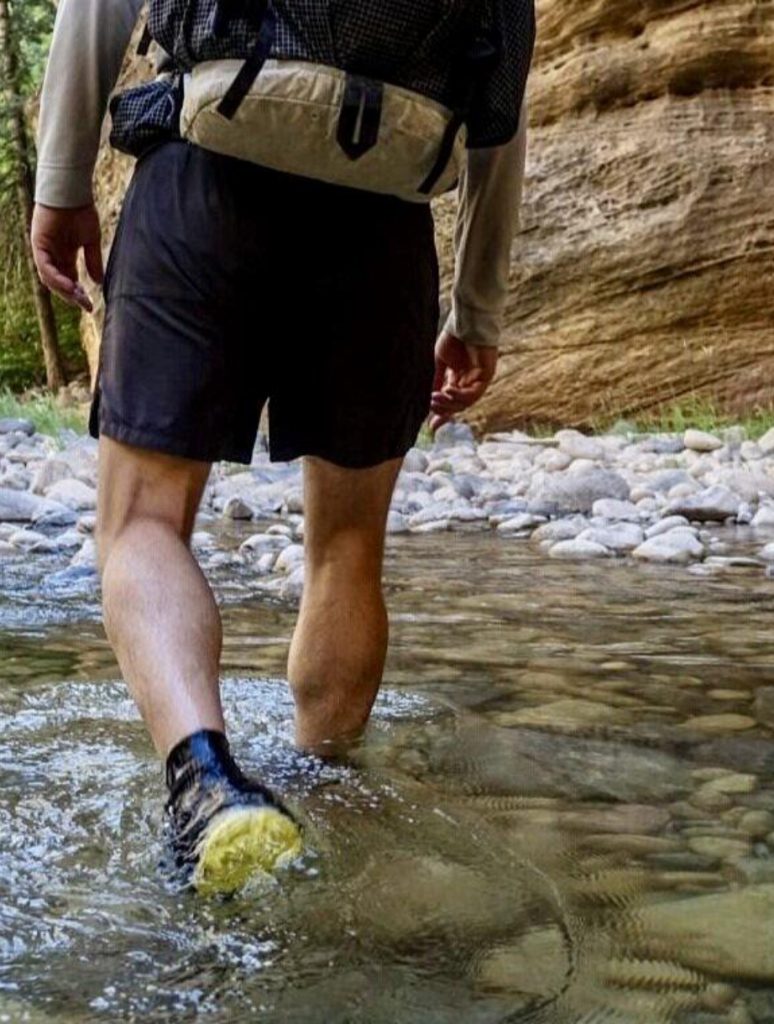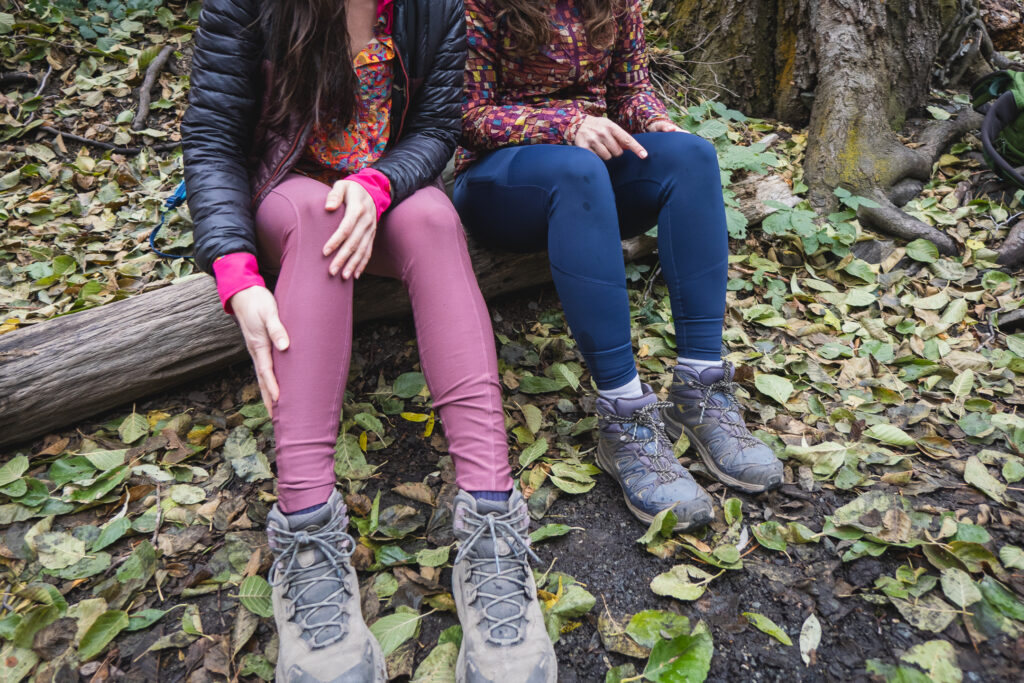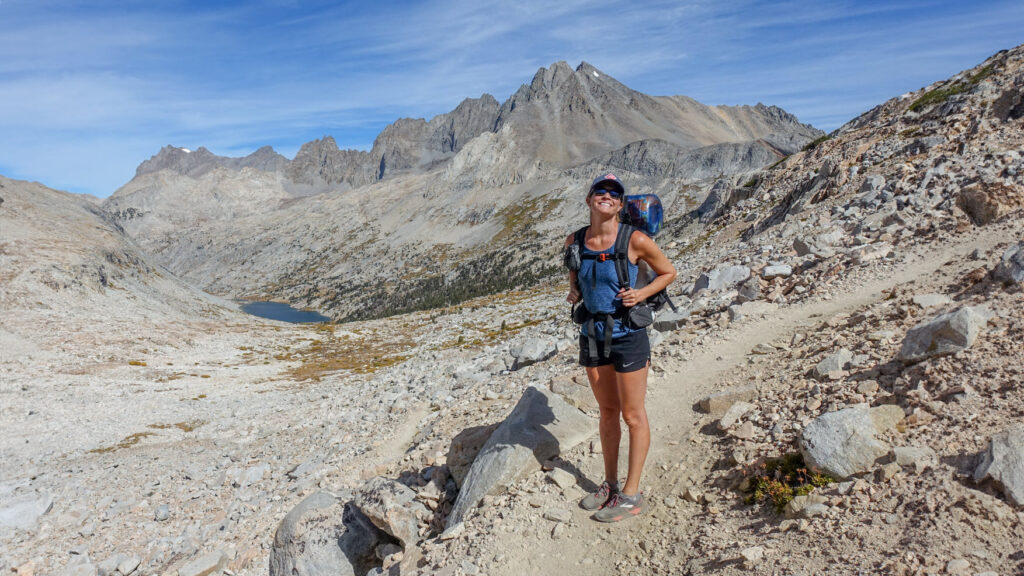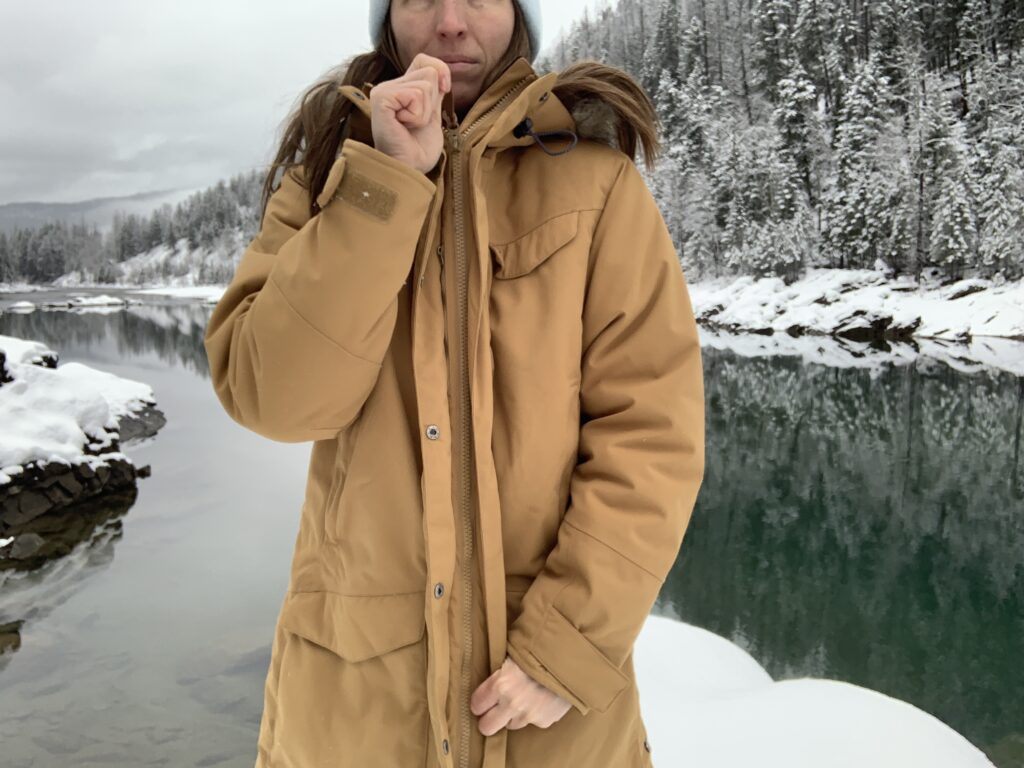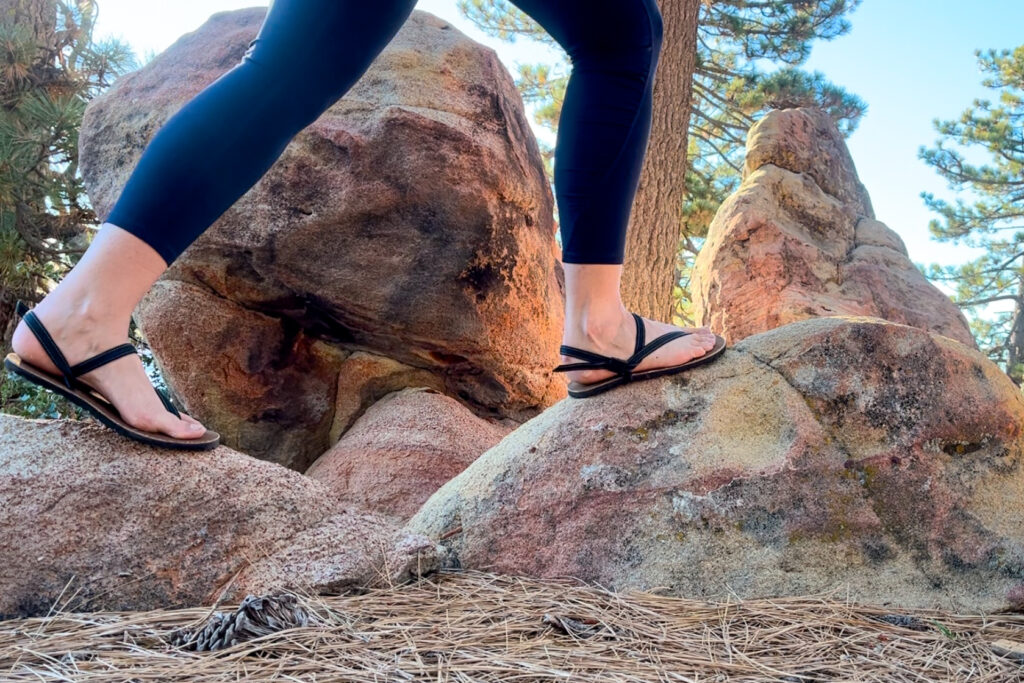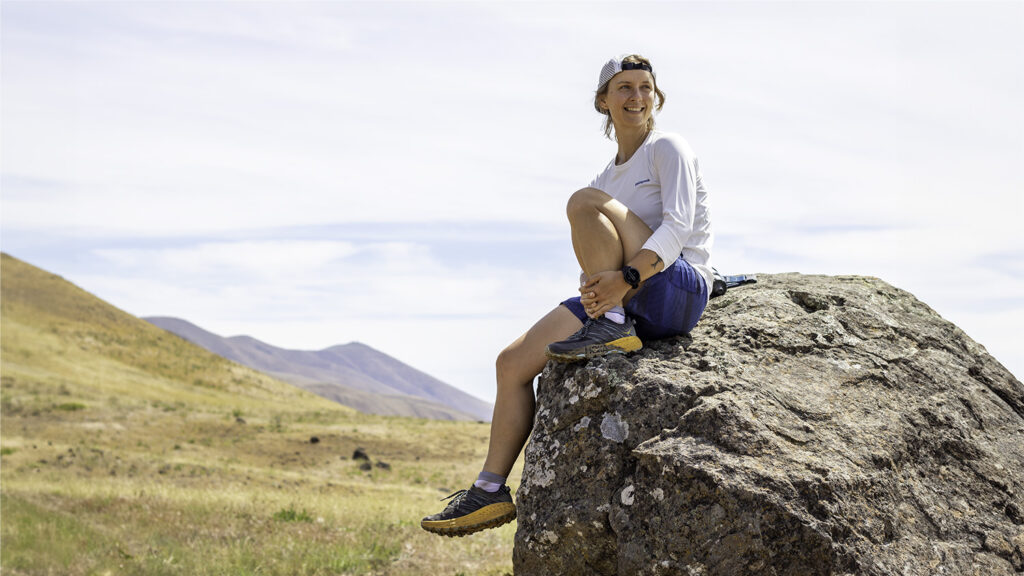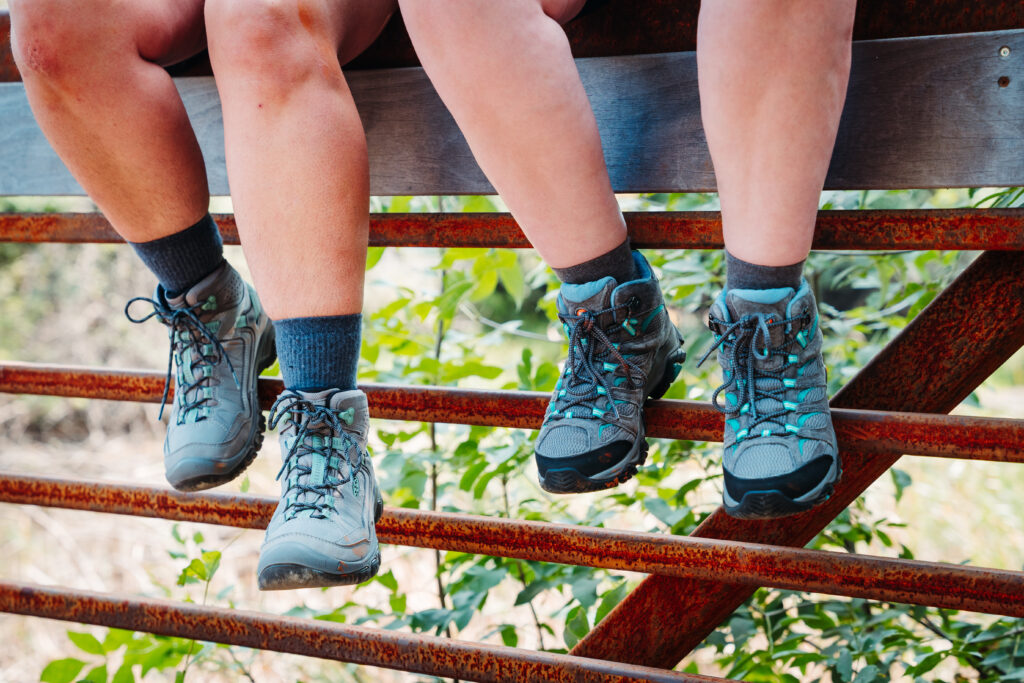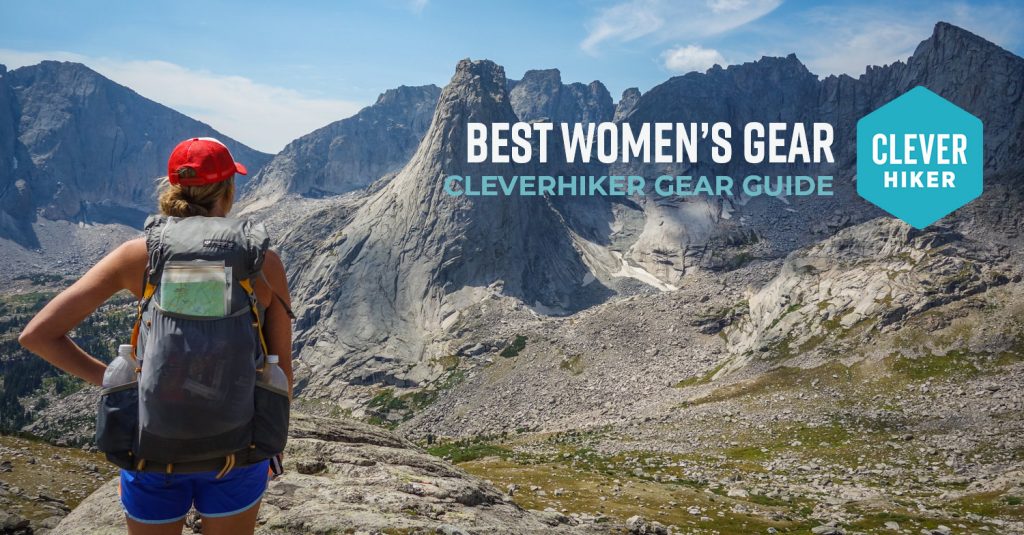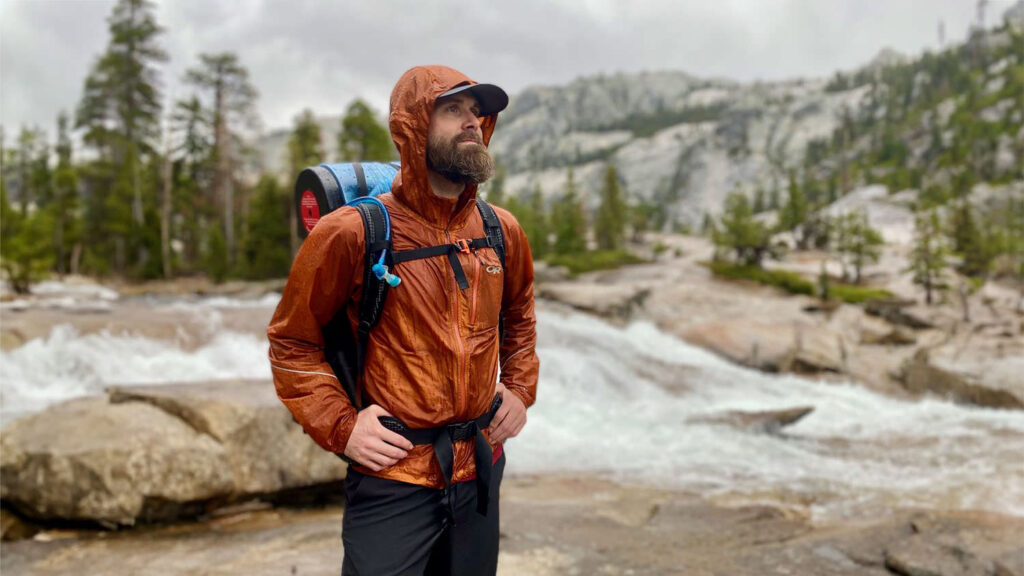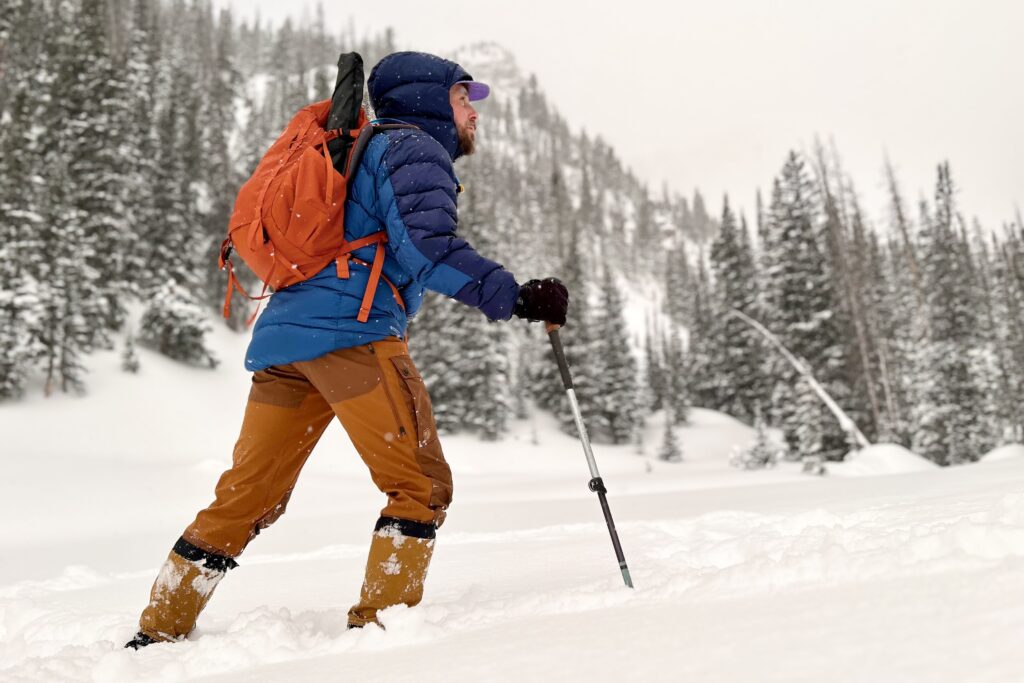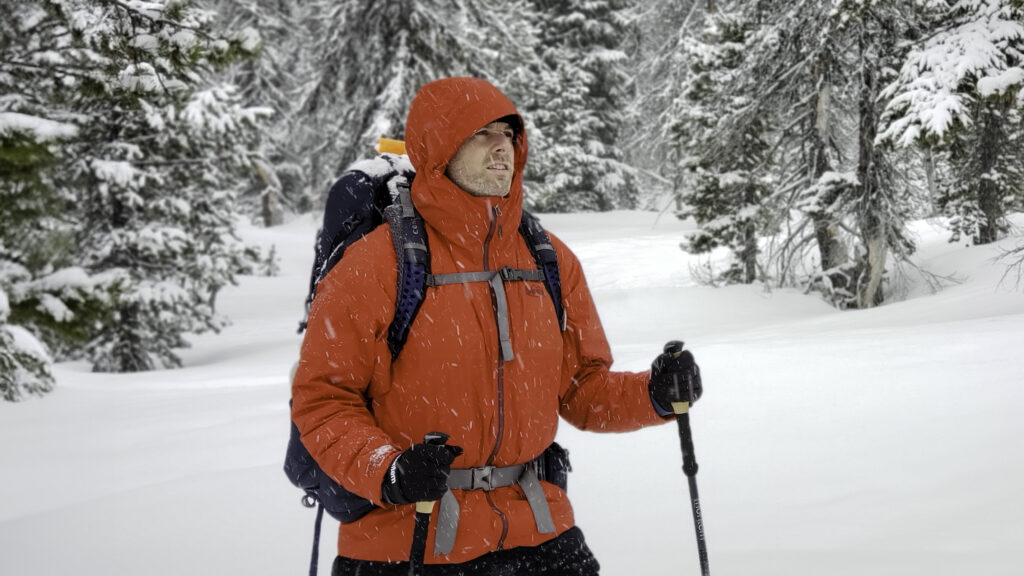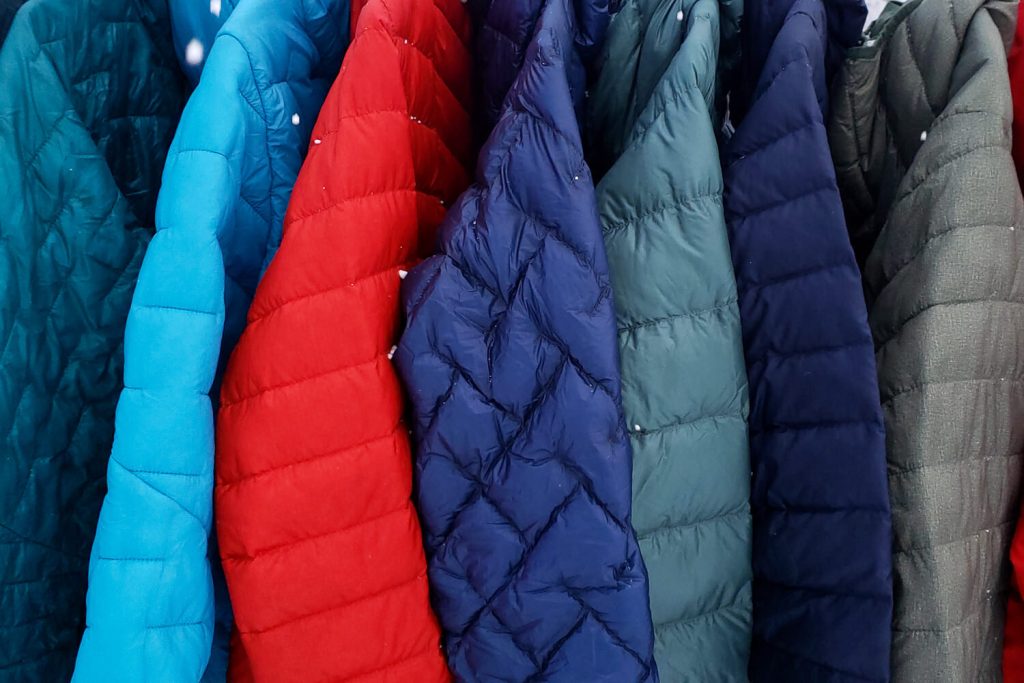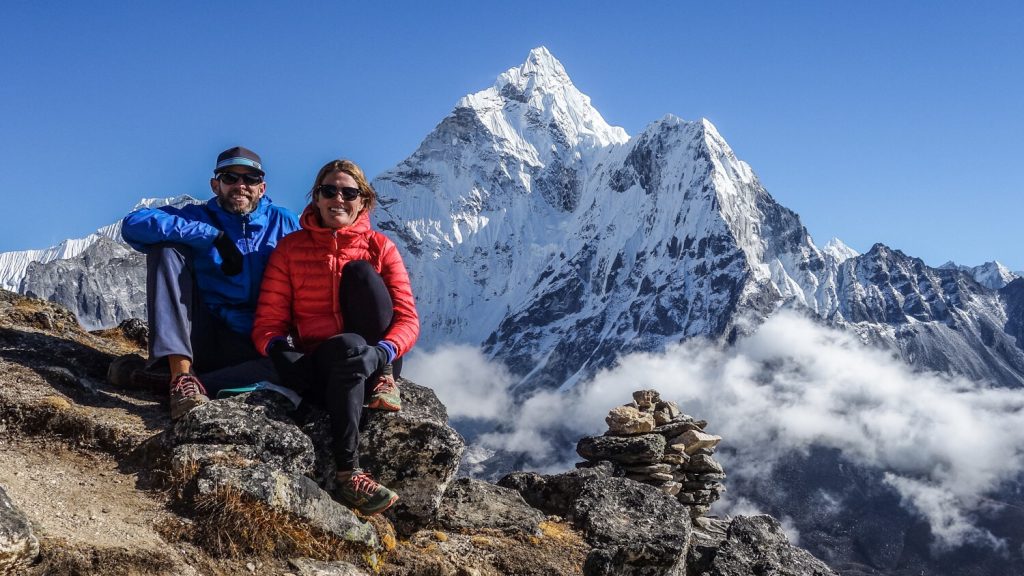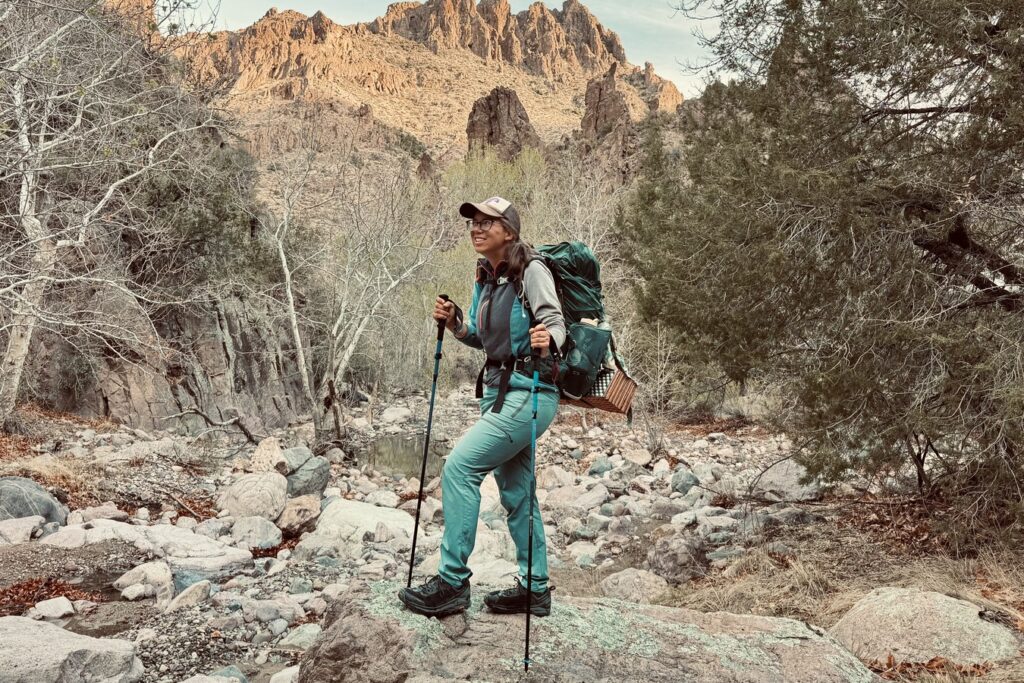
A good pair of hiking pants needs to be comfortable, and easy to move in, durable, breathable, weather resistant and have the right set of features—and it certainly doesn’t hurt if they have a stylish too.
From brands like Athleta, prAna, REI, Patagonia, Outdoor Research and more, our gear testers have hiked in over 50 pairs of hiking pants through rain, sun, and snow over 20,000 miles to determine our favorites. Our expert advice in this guide will take the guesswork out of finding the best women’s hiking pants for you.
And for more info, check out some of our other popular gear guides:
Quick Picks For Women’s Hiking Pants
Check out this quick list of the best hiking pants for women if you’re in a hurry, or continue scrolling to see our full list of favorites with in-depth reviews.
Best Hiking Pants Overall: Arc’teryx Gamma Pant ($200)
Hiking Pants with the Best Features: KUHL Freeflex Roll-Up ($99)
Durable Hiking Pants with a Classic Fit: prAna Halle Straight ($95)
Best Convertible Hiking Pants: REI Sahara Convertible ($90)
Lightweight, Stretchy & Breathable Hiking Pants: Outdoor Research Ferrosi ($99)
Best Budget Hiking Pants: REI Trailmade ($70)
Best Value Hiking Pants: Baleaf Laureate ($38)
Best Jogger Pants: Athleta Trekkie Jogger ($99)
Most Durable Leggings for Hiking: Fjallraven Abisko Trekking Tights HD ($175)
Best Everyday Activewear Pants: The North Face Aphrodite 2.0 ($80)
Exceptionally Comfortable Hiking Pants with a Flattering Fit: Patagonia Happy Hike Studio Pants ($99)
Best Ultralight Hiking Pants for Women: Mountain Hardwear Dynama Ankle ($85)
What’s New
We’ve been hiking the extra miles to test new pairs of hiking pants to see how they stack up against our longtime favorites:
- The Arc’teryx Gamma Pant takes the top spot thanks to incredible durability and weather resistance without sacrificing comfort and breathability.
- After more testing, the KUHL Freeflex Roll-Up pants moved up in our standings. We love the large number of usable pockets and good durability these pants offer.
- We tested the popular Baleaf Laureate pants and found that they offer a lot of bang for the buck.
Women’s Hiking Pants Overall Testing Scores
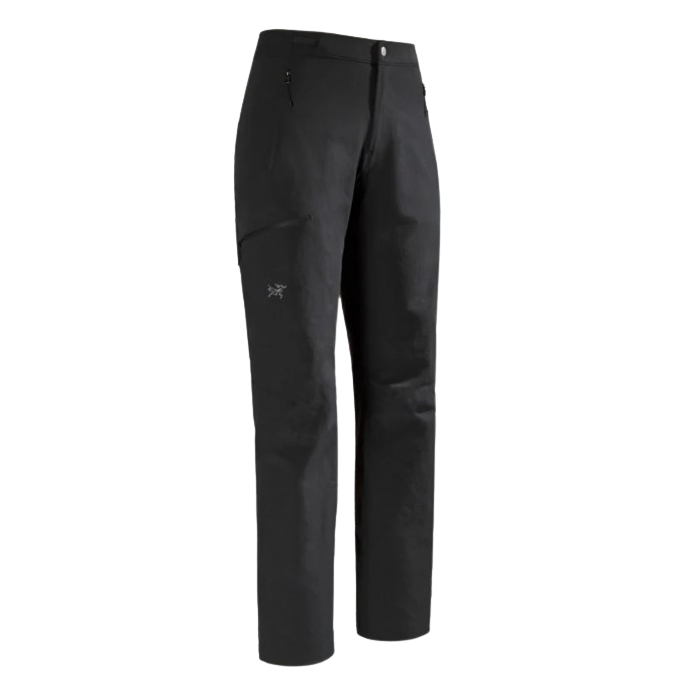
Arc’teryx Gamma Pants
Best Hiking Pants Overall
CleverHiker Rating: 4.9/5.0
Price: $200
Weight: 10.4 oz.
Inseam: 31
Fit: Fitted
Fabric: nylon/spandex weave
Pros
- Extremely durable
- Easy to use waist cinch
- Wind resistant
- DWR finish
- Made with recycled materials
Cons
- Extremely expensive
The Arc’teryx Gamma Pants are a top-tier option for hikers who frequently navigate rugged terrain or face unpredictable weather. In testing, they stood out for their exceptional durability. After hours of bushwhacking through harsh, overgrown trails in Arizona, the fabric remained completely intact—no snags, no tears, and no signs of wear. This level of toughness makes them ideal for backcountry adventurers who need gear that can hold up against constant abuse. While the price tag is steep, the durability and performance justify the investment for those who hike in more extreme environments.
These pants also surprised us with their comfort and mobility. Despite looking similar to rain pants, they feature a soft inner lining and a looser fit that allows for more freedom of movement than expected. Uphill climbs and tricky trail obstacles were no issue, and in side-by-side mobility tests, they outperformed many tighter-fitting models. Breathability is another win. Even in hot, dry Arizona conditions, they stayed comfortable without feeling stuffy or sweat-soaked. They also dried quickly and repelled water longer than any other pants in our lineup during controlled spray tests.
Functionally, they include thoughtful features like an easy-to-use waist cinch and ankle adjustments. However, the pocket design could use some refinement. The thigh pocket shifts when loaded with heavier items like a phone, and the hip pockets are slightly too narrow to carry a phone comfortably without impacting stride. Still, these are relatively minor gripes given the overall performance.
Ultimately, the Gamma Pants are likely overkill for casual hikers sticking to well-maintained trails, but for anyone facing challenging conditions, they offer durability, comfort, and weather resistance that’s hard to beat.
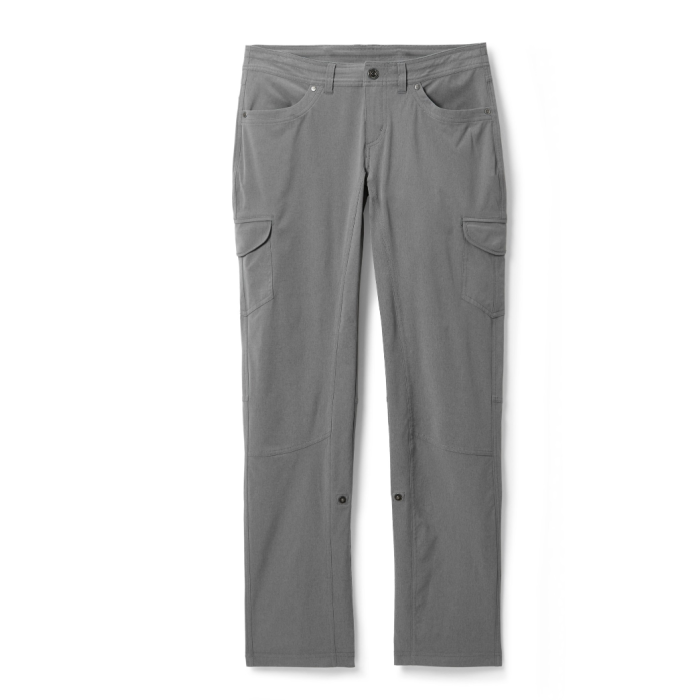
KUHL Freeflex Roll-Up
Hiking Pants with the Best Features
CleverHiker Rating: 4.8/5.0
Price: $99
Weight: 11.9 oz.
Fit: Relaxed
Fabric: Polyester
Pros
- Exceptionally durable
- Soft fabric is very comfortable
- Plethora of pockets
- Articulated knees make them easy to move in
- Highly breathable
- Stylish
- Inclusive sizing
Cons
- Not very weather-resistant
The KUHL Freeflex Roll-Up Pants are one of the most well-rounded pairs of hiking pants we’ve tested, blending impressive durability, comfort, and smart features into a design that performs from Arizona’s deserts to Alaska’s backcountry. What sets these pants apart is how well they hold up to rugged, off-trail use—whether crawling through dense brush or sliding down scree, they emerged nearly unscathed with only minimal signs of wear. This exceptional toughness, combined with a relatively modest price tag, makes them a high-value investment for adventurous hikers.
Despite their burly build, the Freeflex pants are surprisingly comfortable. The fabric feels soft against the skin and moves easily with the body, providing comfort in a more technical, tailored silhouette. Articulated knees and a tapered fit enhance mobility without adding bulk, and they had a modest performance in our mobility tests. They also breathe well and dry quickly, even in cool, damp conditions. After fording glacial creeks in Alaska, these pants dried fast, making them a solid pick for environments where sweat and water crossings are a given.
Functionally, they’re stacked with six well-sized pockets, including secure snap closures that are easy to use one-handed. A drawstring waist, belt loops, and roll-up leg snaps add versatility and ventilation on the trail. The only downside is a lack of water resistance—these pants absorb moisture rather than repel it, so they’re not ideal in heavy rain or wet snow.
That said, for hikers prioritizing performance, durability, and all-day comfort over weatherproofing or casual aesthetics, the Freeflex Roll-Up stands out as a top-tier choice, especially for trips that push into tougher terrain.
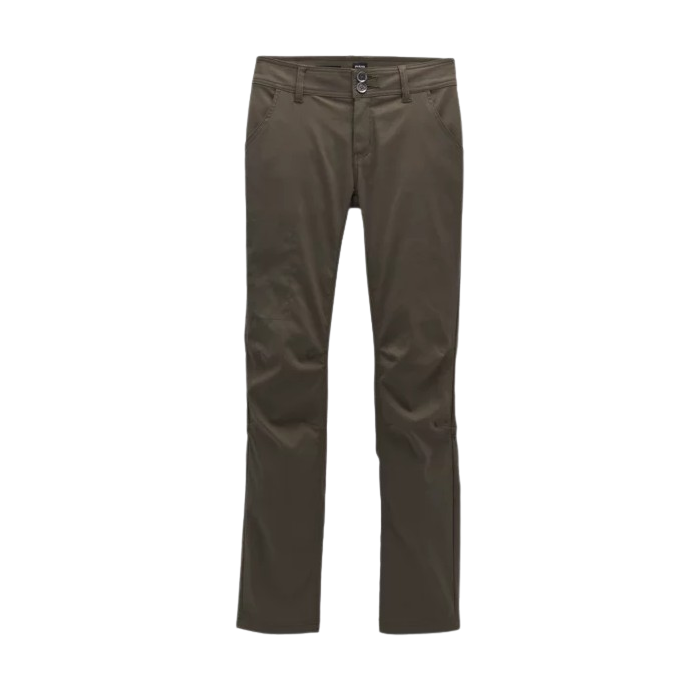
prAna Halle Straight Pant
Durable Hiking Pants with a Classic Fit
CleverHiker Rating: 4.6/5.0
Price: $95
Weight: 12.2 oz.
Fit: Straight Leg
Fabric: 97% Nylon, 3% Elastane
Pros
- Affordable
- Stylish
- Articulated knees make them easy to move in
- Highly breathable
- Inclusive sizing
Cons
- Trades some durability for low weight
The prAna Halle Straight Pants are a solid, all-purpose option for hikers who want classic styling, reliable performance, and a reasonable price. Built with durable materials and a DWR (durable water repellent) finish, they hold up well to brushy terrain and mild moisture, making them a dependable choice for average hiking adventures.
We tested the Halle Pants on rough trails in Arizona’s Blue Range and came away impressed by how well they resisted wear and tear, even after a slip on sharp rocks and navigating through thick burn-area brush. The straight-leg cut and slightly more structured design give them that traditional hiking pant feel. While not the most flexible or cozy pants we tested, they’re comfortable enough for long days on trail and tough enough to handle more rugged terrain.
Breathability and drying speed were about average. These aren’t pants you’ll forget you’re wearing when the sun’s beating down, but they didn’t feel overly hot either. The DWR finish helps shed light moisture, though you’ll want rain gear on hand if the skies open up.
We liked the large, deep hip pockets—they held a phone securely without zippers, even while hiking. The leg and back pockets, however, were less convenient, especially for those with larger phones. A drawstring and belt loops round out the standard feature set.
Overall, the Halle Pants are a great pick for hikers who want a classic look, functional features, and solid durability. They may not be the most breathable or stylish pants out there, but they strike a good balance for those seeking a reliable, go-anywhere option.
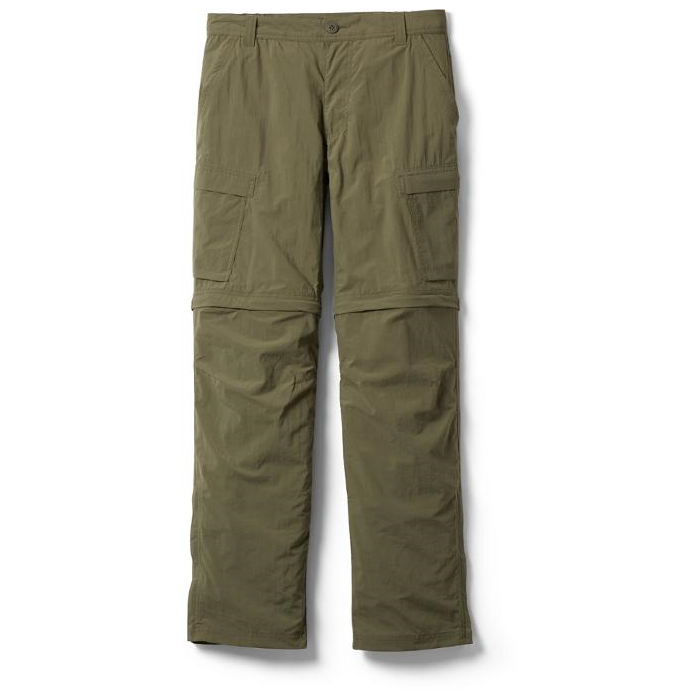
REI Sahara Convertible
Best Convertible Hiking Pants for Women
CleverHiker Rating: 4.5/5.0
Price: $90
Weight: 12.7 oz.
Inseam: 29
Fit: Relaxed
Fabric: 96% nylon, 4% Spandex
Pros
- Highly versatile
- Breathable
- Many useful pockets
- Easily converts to shorts
- Inclusive sizing
Cons
- Top & bottom can show uneven signs of wear
- Somewhat unflattering as pants & as shorts
The REI Sahara Convertible Pants are the perfect solution for hikers torn between pants and shorts. Offering excellent versatility, these pants easily transform into shorts with a simple zip, making them ideal for shifting weather or varied terrain.
On the trail, we were impressed with their quick-drying abilities, especially when tested in the San Juan Mountains. These pants excel at moisture-wicking, drying faster than most we tested, which makes them ideal for rainy or humid conditions. We also appreciated their durability—improved from past models—holding up well against abrasions and even a fall on sharp rocks.
While they shine in practicality, comfort takes a slight hit. The zipper where the pants convert to shorts can cause some resistance when hiking uphill, and the fabric feels less soft than other models we tested. That said, they’re still comfortable enough for a full day of hiking and camping.
The Sahara pants come with an array of functional features, including six pockets – large enough to hold a smartphone – and a waist drawstring with belt loops for a customizable fit. The convertible nature of the pants allows for natural ventilation when in shorts mode, providing breathability and cooling during warmer hikes.
While they lack the softness and style of more casual hiking pants, the REI Sahara Convertible Pants are a great choice for those prioritizing performance, durability, and versatility in technical and backcountry hikes.
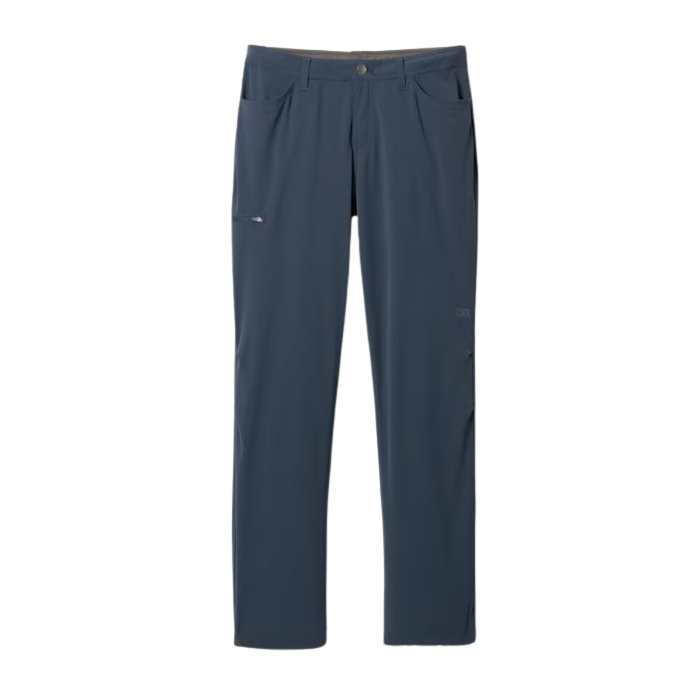
Outdoor Research Ferrosi
Lightweight, Stretchy & Breathable Hiking Pants
CleverHiker Rating: 4.4/5.0
Price: $99
Weight: 9 oz.
Inseam: 30.5
Fit: Straight-leg
Fabric: 86% ripstop nylon, 14% Spandex
Pros
- Exceptionally comfortable
- Articulated knees & stretchy fabric easy to move in
- Highly breathable
- More weather-resistant than many others
- Lightweight
- Length is adjustable with ankle cinch
- Inclusive sizing
Cons
- A bit expensive
- Ankle cinch isn’t very durable
The Outdoor Research Ferrosi Pants stand out for their versatility and water resistance, making them a strong all-around option for everything from office days to moderate hikes. These pants strike a rare balance between technical performance and casual style, thanks to their comfortable stretch fabric, streamlined cut, and thoughtful features. Whether we were road-tripping, hiking steep grades in Arizona’s Chiricahua mountains, or lounging in camp, the Ferrosi never felt restrictive or out of place.
We were especially impressed with how mobile and unrestrictive they felt on high-elevation climbs. The straight-leg fit and light, breathable material allowed for easy movement, and the pants stayed comfortable over long hours of hiking. They’re also surprisingly water-resistant—spray testing showed the fabric beads and sheds water nearly as well as softshell options, making these a solid pick for variable weather or creek crossings.
That said, durability is a bit of a trade-off. The fabric resists tearing better than expected, but it pills quickly when exposed to brush or abrasive vegetation, which was noticeable after just one day of off-trail hiking. For maintained trails or everyday use, though, that’s less of a concern.
In terms of features, the Ferrosi delivers: five usable pockets (all smartphone-friendly), a waist tie, belt loops, and ankle cinches for stream crossings or debris protection. Add in recycled materials and a fair price point, and you’ve got a pant that wears many hats.
If you’re looking for a stylish, functional pair of pants that works as well on mellow hikes as it does in town, the Ferrosi is a great pick—just avoid too much bushwhacking to keep them looking sharp.
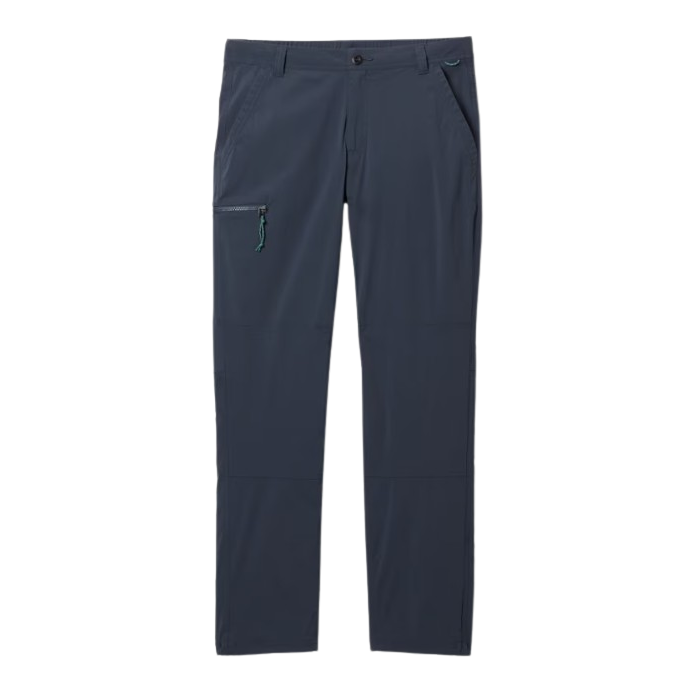
REI Trailmade Pants
Best Budget Hiking Pants
CleverHiker Rating: 4.3/5.0
Price: $70
Weight: 8.1 oz.
Inseam: 29.3
Fit: Relaxed
Fabric: 94% nylon, 6% Spandex
Pros
- Affordable
- Stylish
- Articulated knees make them easy to move in
- Highly breathable
- Inclusive sizing
Cons
- Trades some durability for low weight
The REI Trailmade Pants offer a fantastic combination of comfort, breathability, and affordability, making them an excellent option for beginner hikers or anyone on a budget. We tested these pants on several backpacking trips in the San Juan Mountains, and they held up well on moderate trails. They’re comfortable enough for all-day wear, with a looser fit and softer fabric that makes them a go-to choice for longer hikes.
While they excel in comfort and quick-drying performance, the Trailmade Pants fall short in durability. The fabric is thinner compared to other models, which makes them prone to damage from sharp objects or rough trails. We experienced minor issues like a seam unraveling after hiking through overgrown areas and a hole forming when rubbed against a branch. These pants are better suited for well-maintained trails and fair-weather hikes, rather than rugged backcountry adventures.
In terms of breathability, the Trailmade pants shine. They dry quickly, even in damp conditions, and are cool enough for warmer hikes. We particularly appreciated the five pockets, which are deep enough for modern smartphones, and the easy-to-use zippers on the leg pocket. However, the looser fit did cause heavier items to swing slightly when walking, though it was less noticeable than on some other pants we tested.
With weather resistance, the Trailmade pants are slightly above average, repelling water for a short time but soaking through relatively quickly. However, their quick-drying nature makes this a manageable issue for most hikers.
Overall, the REI Trailmade Pants are a solid choice for those on a budget who plan to hike on well-trodden trails and need a versatile, comfortable pair of pants for moderate outings. They offer great value for the price but aren’t the best option for more rugged, off-trail adventures.
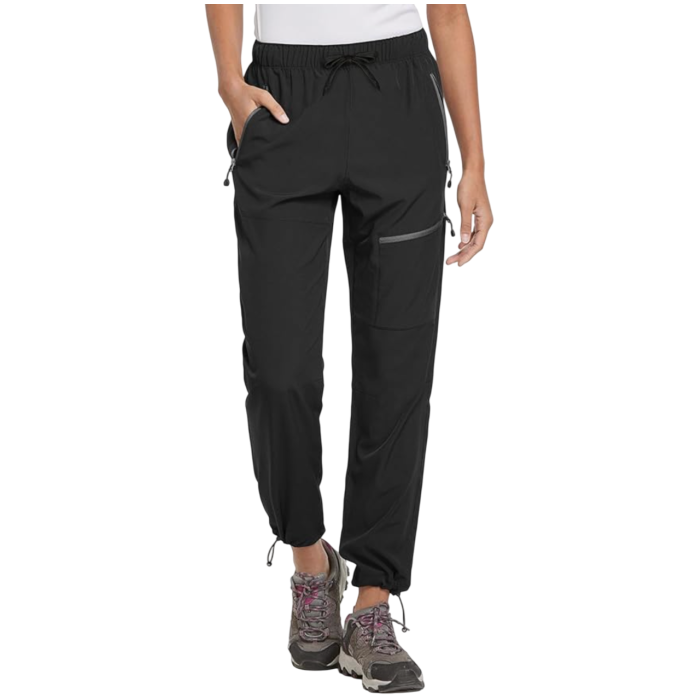
Baleaf Laureate
Best Value Hiking Pants
CleverHiker Rating: 4.2/5.0
Price: $38
Weight: 8.1 oz.
Inseam: 30
Fit: Relaxed
Fabric: 90% Polyester, 10% Spandex
Pros
- Affordable
- Great value
- Mesh pocket liners for increased breathability
- Surprisingly durable for the price
- Many color options
Cons
- Wets out quickly
- Pockets could be larger
The Baleaf Laureate women’s hiking pants offer an impressive balance of durability, comfort, and breathability at an exceptionally affordable price. These pants have proven themselves to be a reliable choice for hiking.
The pants are surprisingly durable, withstanding tough conditions like overgrown trails and even encounters with barbed wire. During our testing, they held up well against sharp objects and rough terrain, making them a great option for those venturing into challenging environments. While they’re not the toughest pants out there, they perform better than many higher-priced alternatives.
In terms of comfort, the Baleaf Laureate pants are versatile and easy to move in, even during more strenuous activities like climbing or pushing through dense brush. The tailored fit, adjustable waist tie, and ankle cinches help achieve a secure and personalized fit, although they might not be the most flattering option for all body types. They are, however, cozy enough to wear casually around the house or for light activities.
Breathability is another strong point, thanks to the mesh-lined pockets and quick-drying fabric. On warm days, they allow for good air circulation, preventing overheating. However, the fit can limit airflow when the pockets are closed, making them less ideal for extremely hot conditions.
One notable downside is the lack of weather resistance. These pants soak through quickly when exposed to moisture, so they’re best suited for dry conditions or paired with rain gear. Overall, the Baleaf Laureate pants are a solid choice for hikers looking for affordable, durable, and comfortable gear, though they’re not the best for wet environments.
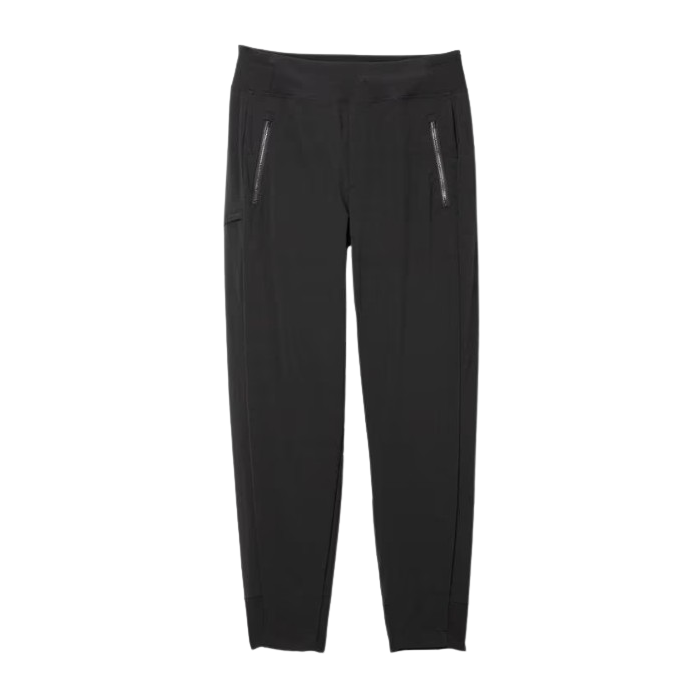
Athleta Trekkie Jogger
Best Jogger Hiking Pants
CleverHiker Rating: 4.1/5.0
Price: $99
Weight: 9.5 oz.
Inseam: 29.3
Fit: Straight
Fabric: 95% Nylon, 5% Spandex
Pros
- Exceptionally comfortable
- Stretchy fabric is easy to move in
- Stylish
- Better pockets than most joggers
- Inclusive sizing
Cons
- Takes a long time to dry
The Athleta Trekkie Jogger Pants strike a great balance between comfort, durability, and everyday functionality, making them a standout option for casual hikes, desert adventures, and active days around town. What sets them apart is their exceptionally comfortable design—thanks to a soft, stretchy fabric, tapered fit, and elastic waistband. They’re stylish, easy to move in, and feel just as good on the trail as they do lounging at home. Though the hip zipper pockets can feel a bit clunky when holding bulkier items, the overall fit and ease of wear more than make up for it.
Durability is another highlight. Despite their lightweight feel, these joggers impressed us during field testing, holding up well against abrasion and rough terrain without showing signs of wear. The ripstop weave gives them a level of toughness that outperforms many similar jogger-style hiking pants. For anyone who’s tired of babying delicate fabrics, this makes them a reliable pick for multi-sport use or high-mileage days.
That said, the biggest drawback is their poor performance in wet conditions. In our side-by-side water tests, they absorbed moisture immediately and dried much more slowly than any other pants in the lineup. For this reason, we wouldn’t recommend them for wet climates or extended backcountry trips where the weather is unpredictable. But for dry hikes, travel, or everyday outdoor wear, they shine.
Ultimately, these joggers are perfect for hikers who prioritize comfort and versatility over hardcore technical performance. If your adventures are mostly fair-weather or based in drier regions, they’re a stylish, functional choice that holds up to real trail use while feeling like your favorite pair of lounge pants.
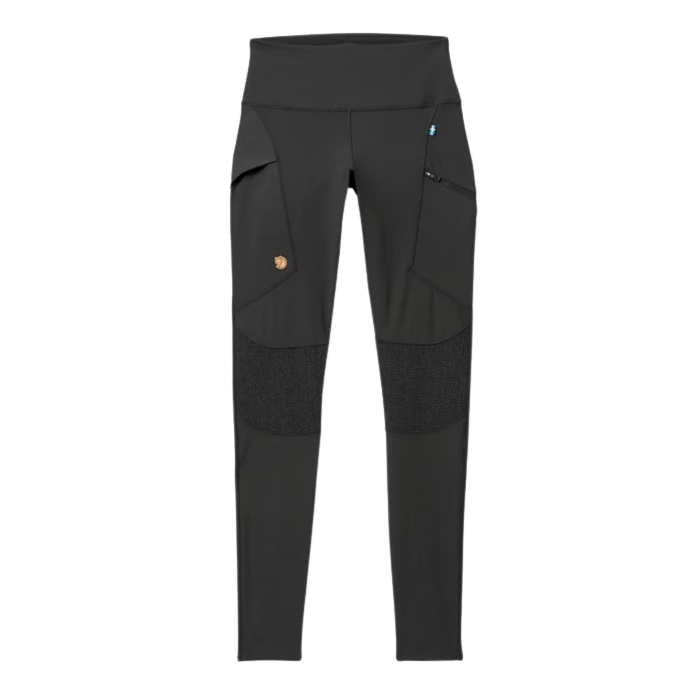
Fjallraven Abisko Trekking Tights HD
Most Durable Leggings for Hiking
CleverHiker Rating: 4.0/5.0
Price: $175
Weight: 8.6 oz.
Inseam: 32
Fabric: 71% polyester, 29% elastane, Cordura in reinforced areas
Pros
- Exceptionally durable
- Stretchy fabric is easy to move in
- Lightweight
- Very comfortable
- Useful pockets
Cons
- Expensive
- Ankle height isn’t as protective as full-length pants
- A bit warm for hot summer conditions
The Fjallraven Abisko Trekking Tights HD are a technical pair of leggings designed for backpackers who want a balance of comfort and durability in the backcountry. After testing them in Arizona’s rugged Chiricahua Mountains, we were pleasantly surprised. These leggings handled steep climbs, rocky scrambles, blowdowns, and even snow, quickly becoming a go-to for moderate to difficult hikes. While the stretchy polyester fabric is prone to pilling when scraped against bushes, the reinforced knees and seat dramatically improved their durability where it mattered most.
Comfort is one of the biggest strengths here. These leggings feel great against the skin, move easily with the body, and offer a flattering, supportive fit. On long hikes, especially under a backpack, they were among the most comfortable options we tested. However, they do tend to slip down over time—a minor issue while backpacking, thanks to a hip belt, but a major annoyance during high-motion activities like trail running. The included waist tie didn’t do much to help.
The Abisko tights fall short when it comes to moisture management. They absorb water quickly and are among the slowest to dry in our lineup. While breathable enough for warm weather hikes, their lack of water resistance makes them a poor choice for wet environments or cold, damp conditions.
Feature-wise, they’re more equipped than most leggings. The zippered and envelope-style thigh pockets are both secure and functional, and the reinforced panels boost abrasion resistance. Still, their high price point and limited weather protection make them best suited for dry backpacking trips, moderate scrambling, or mixed-terrain hikes—just not for trail running or rain-soaked adventures.
More: Women’s Fjallraven Abisko Trekking Tights HD Full Review
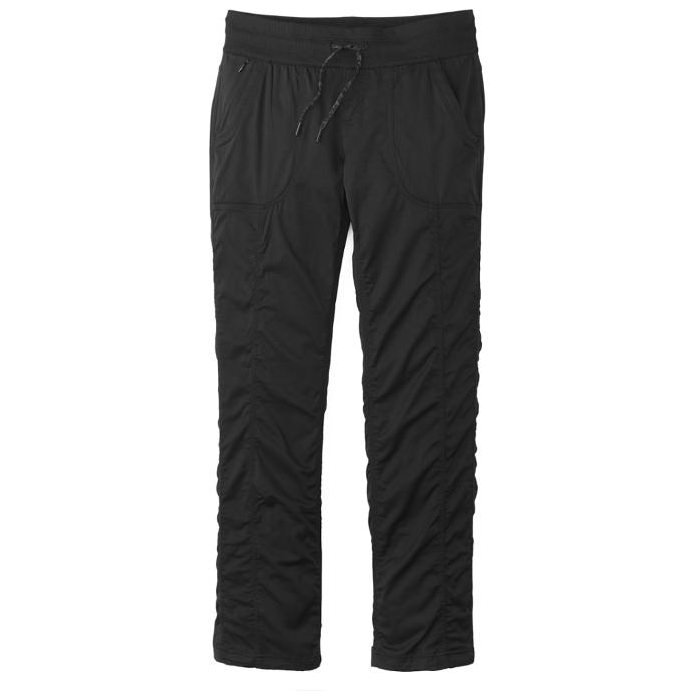
The North Face Aphrodite 2.0
Best Everyday Hiking Pants
CleverHiker Rating: 3.9/5.0
Price: $80
Weight: 8.6 oz.
Fit: Straight-leg
Fabric: 95% nylon, 5% elastane
Pros
- Above-average comfort
- Less expensive
- Easy to adjust length with ankle cinch
- Stretchy fabric is easy to move in
- Lightweight
- Inclusive sizing
Cons
- Minimal pockets
- Not as durable
The North Face Aphrodite 2.0 Pants strike a great balance between the comfort of joggers and the functionality of hiking pants. We found them ideal for both the trail and lounging, thanks to their soft material and relaxed fit. On our backpacking trips in southern Colorado, they became a go-to choice due to their comfort and mobility, with a fit that’s just loose enough to offer freedom without feeling restrictive.
These pants offer a fair amount of functionality, though they fall short in durability. While they’re comfortable for light to moderate hikes, we noticed signs of wear, including piling and loose threads, after a few trips. They performed decently when rubbed against rough surfaces but aren’t built for more rugged, off-trail conditions.
In terms of breathability, the Aphrodite 2.0 pants are functional but not exceptional. The looser fit allows for some airflow, but they were slower to dry in side-by-side tests and stayed damp longer in the field on rainy days. However, they still performed well enough for casual hikes or trips with mild conditions.
For pockets, the pants feature two hip pockets and a zipper pocket on the right side. While the zipper adds security for smaller items, it could be easier to use, as the small teeth sometimes create resistance. Other practical features include a drawstring waist and adjustable ankle cinches, which help with fit and comfort.
As for weather resistance, these pants fall short. Despite a DWR finish, they soaked through quickly when exposed to water, which makes them less suitable for wet conditions without additional rain gear. However, they are comfortable enough to wear underneath rain pants.
In conclusion, the North Face Aphrodite 2.0 Pants are a solid option for anyone looking for comfort and flexibility in their hiking pants. While they’re not the best choice for tough, off-trail adventures, they offer great value for casual hikes, everyday wear, or lighter outdoor activities.
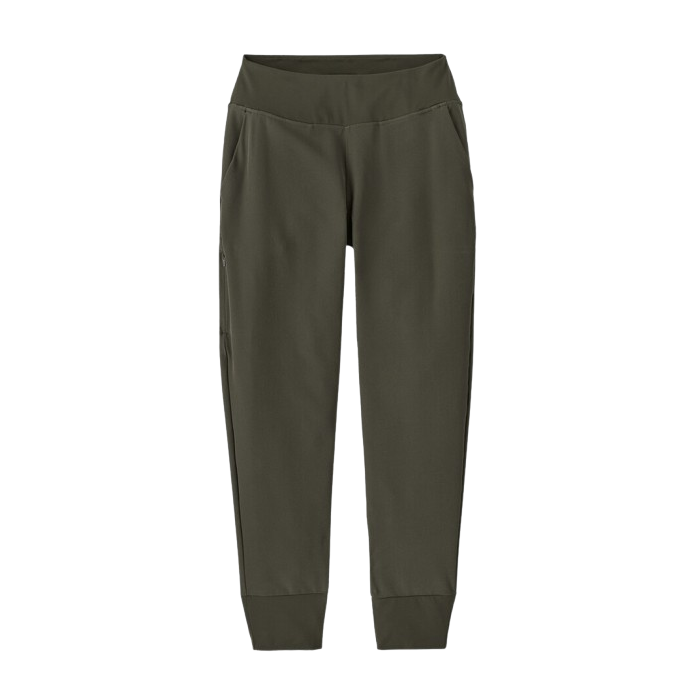
Patagonia Happy Hike Studio Pants
Exceptionally Comfortable Hiking Pants with a Flattering Fit
CleverHiker Rating: 3.8/5.0
Price: $99
Weight: 9.4 oz.
Fit: Tapered, ankle cut
Fabric: 89% polyester, 11% Spandex
Pros
- Exceptionally comfortable
- Stretchy fabric is easy to move in
- Breathable
- Stylish
- Made in a Fair Trade Certified factory
Cons
- A bit expensive
- Ankle height isn’t as protective as full-length pants
- No waist adjustments
- Pockets aren't as practical
The Patagonia Happy Hike Studio Pants are all about comfort—whether you’re on trail, in camp, or lounging at home. With their relaxed fit, soft fabric, and jogger-style design, they’re among the most comfortable pants we tested. The elastic waistband and ankle cuffs keep things simple and functional, while the looser cut allows for excellent mobility on mellow trails or during recovery time after a long day outdoors.
Where these pants shine is in their wearability. On a backpacking trip in Arizona’s White Mountains, they quickly became our go-to for evenings at camp and sleeping, thanks to the unrestrictive fit and lack of bulky hardware. We also appreciated the hip pockets—they’re deeper than those on many joggers, keeping a smartphone secure while hiking. However, the remaining pockets were less useful, especially for larger phones, and the waistband stretched out after a day of use without any way to cinch it back down.
In terms of durability, these pants held up reasonably well for their category. While they did pick up thread pulls when we encountered brush, they resisted tearing even after some knee-scraping tumbles. That said, they’re not suited for rugged or off-trail adventures.
The main drawback is poor weather resistance. The fabric soaks up water quickly and takes a long time to dry, so we wouldn’t recommend them for wet or humid conditions. Still, for dry-weather hikes or day-to-day wear, they’re a solid pick.
If you’re looking for joggers that feel as good on the couch as they do on the trail, the Happy Hike Studio Pants are a top contender—just don’t take them too far off the beaten path.
More: Patagonia Happy Hike Studio Women’s Hiking Pants Full Review
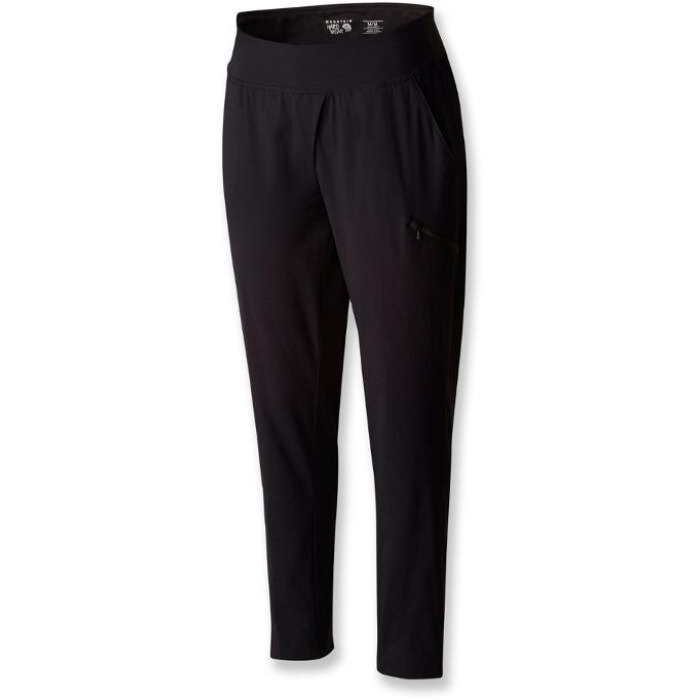
Mountain Hardwear Dynama Ankle
Best Ultralight Hiking Pants
CleverHiker Rating: 3.8/5.0
Price: $85
Weight: 6.6 oz.
Inseam: 30
Fit: Tapered, ankle cut
Fabric: 94% nylon, 6% elastane
Pros
- Exceptionally comfortable
- Less expensive
- Stylish
- Ultralight
- Breathable
- Stretchy fabric is easy to move in
- Inclusive sizing
Cons
- Ankle height isn’t as protective as full-length pants
- Minimal pockets
- Waistband stretches over time
The Mountain Hardwear Dynama Ankle Pants strike a strong balance between comfort and style, making them a solid pick for casual hikes, laid-back backpacking trips, and town-to-trail transitions. Their lightweight, breathable fabric and relaxed-yet-flattering fit make them a go-to for warm weather outings where comfort takes top priority. These pants feel great on the skin, move easily with the body, and are stylish enough to wear straight from the trail to a post-hike dinner.
During testing in the San Juans, we found that while they perform well in terms of breathability and drying time, the Dynama is best suited for mellow trails. Their minimalist pockets proved to be more aesthetic than functional—our phones slipped out multiple times, and the zippered leg pocket was awkwardly placed and tough to access, especially for right-handed users. The waistband stretched out quickly and left the pants slipping by the end of the day. Fortunately, newer models now come with a drawstring at the waist.
In terms of durability, these pants aren’t built for heavy bushwhacking or rough terrain. While they survived some basic abrasion testing, we found loose threads and pulled fabric after only moderate use. However, for ultralight hikers or anyone seeking a low-bulk option for warm, dry conditions, they’re still a decent choice. They also dry quickly and breathe well enough to stay comfortable in hot climates, though they won’t provide much protection from the elements.
All in all, the Dynama Ankle Pants are ideal for those prioritizing comfort, weight, and everyday style over trail-hardiness.
Product Comparison Table
| oSort | Product | Price | Weight | Inseam | Fit | Fabric | Comfort | Durability | Breathability | Features | Weather Resistance | 0 |
Arc’teryx Gamma Pants View at REI |
$200 | 10.4 oz. | 31 | Fitted | nylon/spandex weave | 4.2 | 5.0 | 4.7 | 3.9 | 4.9 | 1 |
KUHL Freeflex Roll-Up View at REI View at KUHL |
$99 | 11.9 oz. | 26.5 | Relaxed | Polyester | 4.3 | 4.8 | 4.4 | 4.9 | 3.9 | 2 |
prAna Halle Straight Pant View at prAna |
$95 | 12.2 oz. | 30 | Straight Leg | 97% Nylon, 3% Elastane | 4.0 | 4.6 | 4.4 | 4.3 | 4.5 | 3 |
REI Sahara Convertible View at REI |
$90 | 12.7 oz. | 29 | Relaxed | 96% nylon, 4% Spandex | 3.7 | 4.5 | 4.9 | 4.8 | 4.6 | 4 |
Outdoor Research Ferrosi View at REI View at Amazon |
$99 | 9 oz. | 30.5 | Straight-leg | 86% ripstop nylon, 14% Spandex | 4.5 | 3.8 | 4.4 | 4.5 | 4.8 | 5 |
REI Trailmade Pants View at REI |
$70 | 8.1 oz. | 29.3 | Relaxed | 94% nylon, 6% Spandex | 4.4 | 3.8 | 4.9 | 4.7 | 4.3 | 6 |
Baleaf Laureate View at Amazon |
$38 | 8.1 oz. | 30 | Relaxed | 90% Polyester, 10% Spandex | 4.1 | 4.6 | 4.5 | 4.2 | 4.8 | 7 |
Athleta Trekkie Jogger View at Athleta |
$99 | 9.5 oz. | 29.3 | Straight | 95% Nylon, 5% Spandex | 4.9 | 4.3 | 3.1 | 3.9 | 3.6 | 8 |
Fjallraven Abisko Trekking Tights HD View at REI View at Amazon |
$175 | 8.6 oz. | 32 | Next to skin, high waist | 71% polyester, 29% elastane, Cordura in reinforced areas | 3.9 | 4.1 | 4.1 | 3.7 | 3.5 | 9 |
The North Face Aphrodite 2.0 View at REI View at Amazon |
$80 | 8.6 oz. | 29 | Straight-leg | 95% nylon, 5% elastane | 4.8 | 3.8 | 4.1 | 4.1 | 3.7 | 10 |
Patagonia Happy Hike Studio Pants View at REI View at Patagonia |
$99 | 9.4 oz. | 32 | Tapered, ankle cut | 89% polyester, 11% Spandex | 4.6 | 3.5 | 3.5 | 4.1 | 4.1 | 11 |
Mountain Hardwear Dynama Ankle View at REI View at Amazon |
$85 | 6.6 oz. | 30 | Tapered, ankle cut | 94% nylon, 6% elastane | 4.7 | 3.4 | 4.7 | 3.5 | 4.0 |
|---|
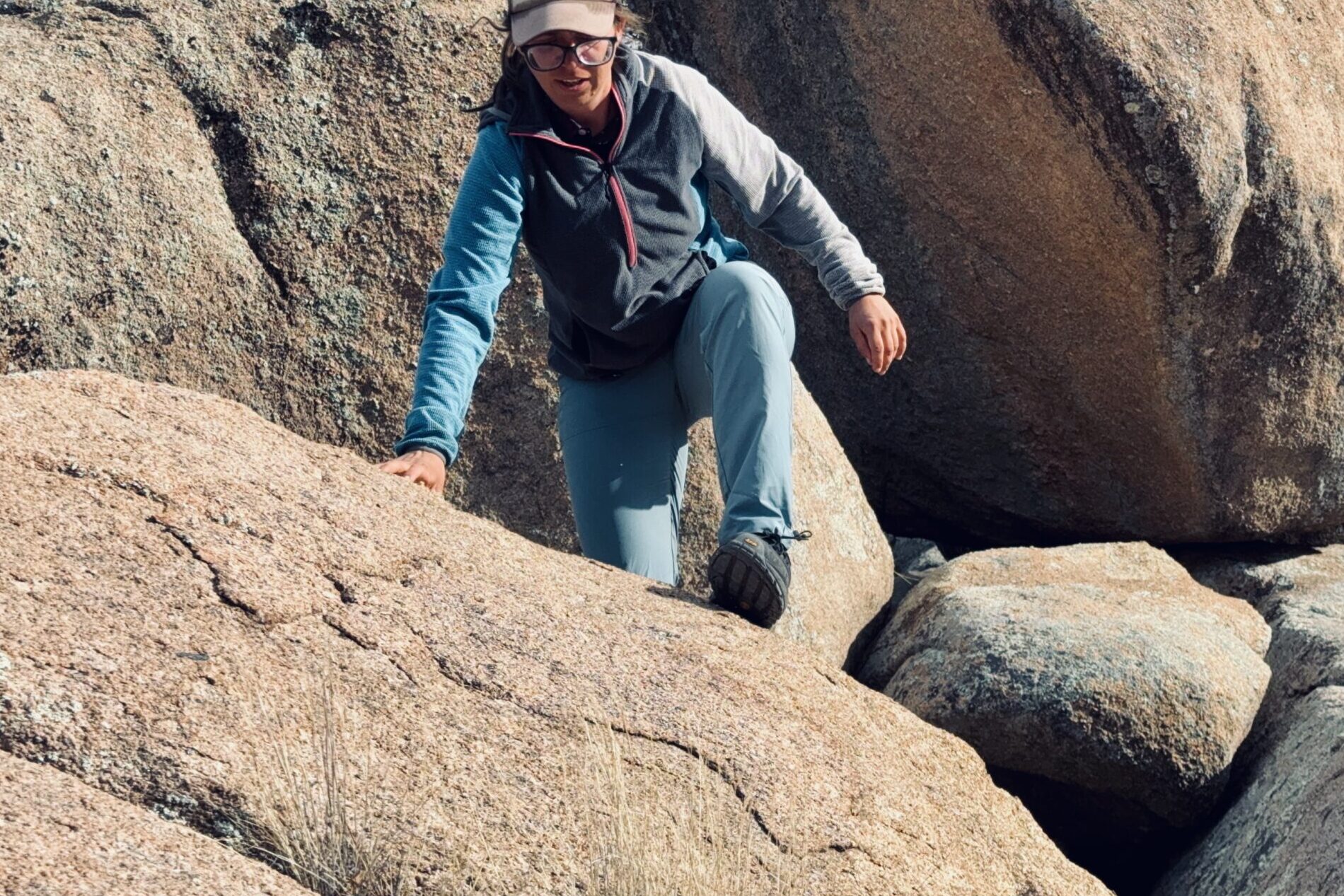
How We Test & Methodology
We rigorously tested each pair of pants using a variety of metrics to determine which was the best. Our process looked at comfort and mobility, durability, breathability, features, and weather resistance. We spent several weeks using these pants on day hikes and backpacking trips around the San Juan mountains.
COMFORT & MOBILITY
One of our biggest pet peeves when wearing pants on the trail is the feeling of resistance on the legs while hiking uphill. The extra effort needed to lift the leg when the body is already at maximum exertion is literally a drag. For that reason, we tested each pair of pants for mobility by measuring how high we could lift each leg before feeling resistance from the pants. We started with the leg on the ground and lifted the leg until the pants seemed to pull against the leg. At this point, we stopped and then measured the distance from the edge of the knee to the ground. We repeated this process with the other leg and then averaged the distances. We used this data to compare the mobility of each pair of pants and assign initial rankings.
The second component of this metric is how comfortable each pair of pants is. We wore each pair of pants on at least one backpacking trip, where we had a fully loaded pack and hiked anywhere from five to 20 miles per day. We noted how the pants felt: were they tight or constricting in places? Were there any weird pressure points from zippers? How did the waistband feel with a pack on? How did the fabric feel on the skin both while sitting and walking? Did we feel like we looked good while wearing them? Which pants did we want to spend time wearing and why? After addressing those questions, we used the results to adjust the final rankings from our mobility results.
DURABILITY
The longevity of gear is an important consideration when choosing pieces that provide good value and are reliable on the trail. Along the same lines, a big reason we skip the shorts and go for pants is that they provide extra protection from pokey plants, snagging bushes, and sharp rocks. With those reasons in mind, durability was a key area of testing when evaluating the quality of each pair of pants.
To test for durability, we conducted individual and side-by-side reviews. Each pair of pants was taken out into the Colorado Rockies on various backpacking trips. These trips allowed us to see how the pants held up to a fully loaded pack on the hips, the potential wear on the ankle cuffs from mud and rocks, and just general regular use. We wanted to keep things fair as there was variety in the trail conditions on our hikes. To do so, we took each pair of pants and rubbed a section of the fabric on rough materials such as tree bark and a pokey branch to see how the fabric would react
BREATHABILITY
Rain, water crossings, dew, and sweat happen. When they do, wearing pants that quickly wick away the moisture is highly beneficial. To analyze this, we lined up all the pants we tested and dunked the bottom three inches in water to soak the fabric. Then, we timed how long it took the fabric to dry and gave each model a ranking. By performing this test side-by-side, we ensured that conditions like the amount of wind, sunshine, temperature, and humidity were the same for every pair of pants. We also considered other features that affect breathability, such as the ventilation qualities of the pants and how hot we felt while wearing them.
FEATURES
There are a variety of features that can be found in hiking pants. We focused primarily on usable pockets and considered secondary features such as whether or not pants had waist drawstrings, belt loops, ankle cinches, convertible pants, or leg zippers. When looking at pockets, we placed an iPhone 15 Pro in one pocket at a time, then jumped up and down three times in a row. If the phone stayed in the pocket, we counted it as usable. We repeated this process for each pocket and then tallied the total number of usable pockets for each pair of pants. Rankings were primarily based on the number of pockets, with secondary features also considered.
WEATHER RESISTANCE
The final metric we considered was how water-resistant each pair of pants was. To test this, we wore each pair of pants and then used a squirt bottle set on the mist setting to spray the pants from about a foot away. We counted the number of squirts needed for the water to stop beading on the outer layer and start soaking into the fabric. This number of squirts was used to rank the pants, along with our experience using these models in the field in wet conditions.
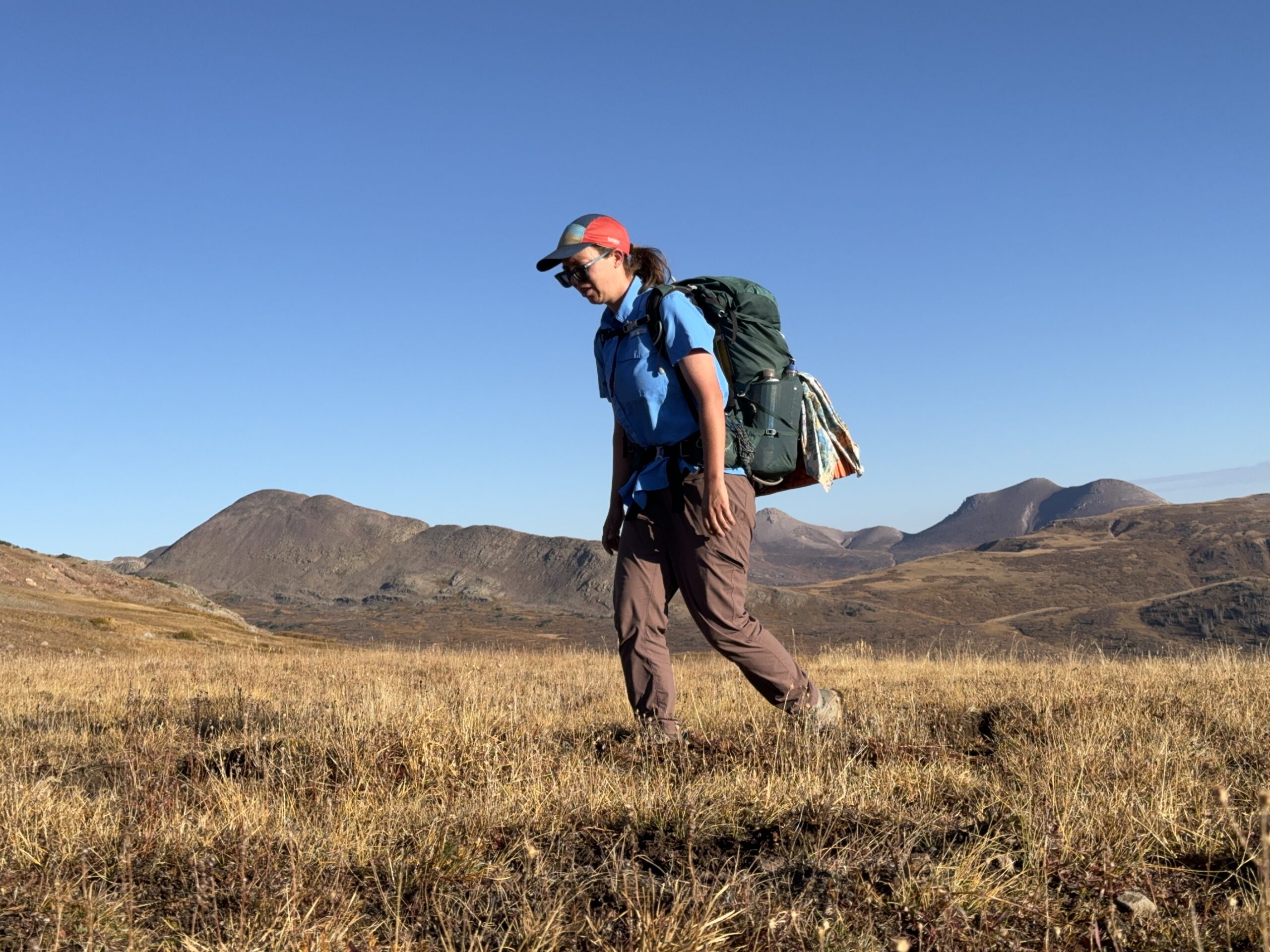
Why Trust CleverHiker?
Gear Analyst, Bailey Bremner, has covered some major backcountry ground. With over 600 nights and around 8,500 miles on trails across the U.S. with various pairs of pants, she knows hiking pants inside and out. She relied on pants to protect her legs while hiking rugged, off-trail routes such as the Western Wanderer Route, Columbine Route, and San Luis Loop, as well as classic thru-hikes, including the Colorado and Continental Divide Trails. While bushwhacking through the wilderness, she learned firsthand the importance of reliable gear and has made it her mission to become an expert on backpacking equipment.
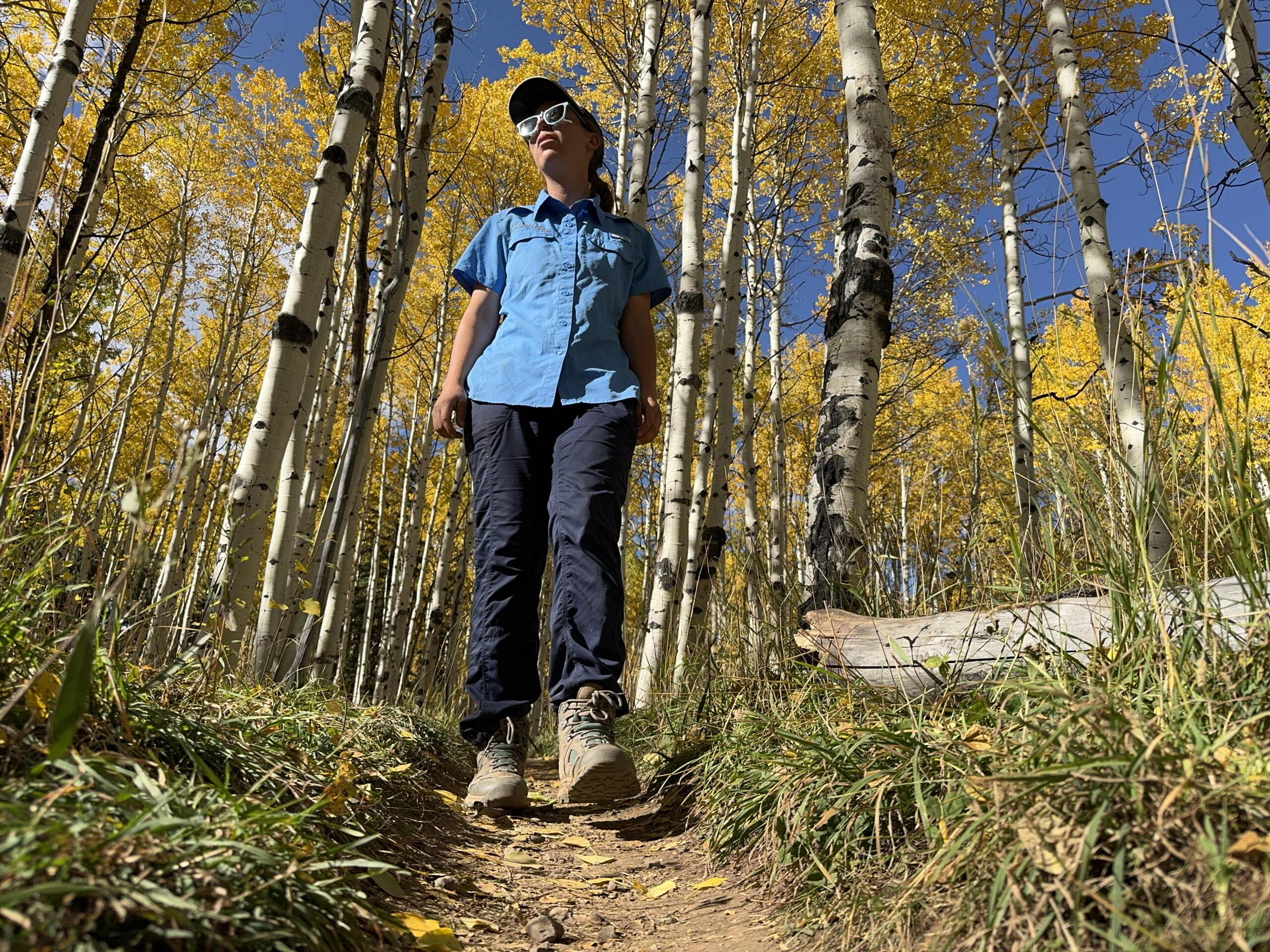
Analysis & Results
We rank hiking pants based on six metrics: value, comfort & mobility, durability, breathability, features, and weather resistance. Our comparative results below outline the top performers in each metric.
VALUE
Most of the pants we tested have similar price tags, but there are a few that offer superior performance at the price point. On the more affordable side, the Baleaf Laureate pants are significantly more affordable than any other pair of pants we tested. Initially, we expected them not to perform as well due to the smaller price tag, but they defied our expectations with a respectable performance across the board. Specifically, we like that the Baleaf pants have mesh pockets for better breathability and durability that is better than many more expensive pairs of pants. The REI Trailmade pants also scored well across the board. Their many usable pockets and quick drying time make them well worth the purchase for beginner hikers on a budget.
We also like the KUHL Freeflex Roll-Up and the REI Sahara Convertible pants because both pants are very reliable and offer high-quality options with a variety of features, breathability, and durability, all at a competitive price. Their durability means these pairs should last, saving you some green in the long run. The prAna Halle Straight and Outdoor Research Ferrosi are other options that scored above average overall in our testing and fall into the cluster of pants in the middle price point.
There is also a cluster of pants in that middle price point, which scored lower in our testing, indicating that they might not offer as much value. However, it is important to consider the style of pants and what they will be used for. Buyers looking for jogger-style pants may consider the Athleta Trekkie North Joggers, for instance, as they offer the best bang for the buck for that style. Though The North Face Aphrodite 2.0 pants scored lower overall, they are an excellent option for comfort and still make a great choice for those who prioritize that feature. Likewise, the Patagonia Happy Hike and Mountain Hardwear Dynama Ankle are better suited for everyday wear, so users who plan to use them around town with the occasional laid-back hike may value them more.
The other major outlier in the lineup is the Fjallraven Abisko Trekking Tights HD as they are by far the most expensive model we tested. While they scored around average overall, the larger price tag might be worth it for those who would rather hike in leggings than traditional pants.
COMFORT & MOBILITY
Technical performance and features will only matter if the pants are comfortable to wear all day. We found a few standout favorites that were the least restrictive, felt effortless to move in, and generally the most pleasant to wear. Our overall most comfortable pair of pants was the Athleta Trekkie Jogger. We like that they are loose around the knees but fit well around the hips and ankles, making it easier to hike up a steep hill and lounge around on the couch. They also work well for anyone who mountain bikes.
Other standouts include the Mountain Hardwear Dynama Ankle and The North Face Aphrodite 2.0 pants. We found that the cut of the Dynama pants is flattering, which made us feel good and, thus, mentally comfortable wearing these pants. Like the Trekkies, they have the looser fit found in joggers, which makes it easier to move around. Less bulky features, like smaller zippers, make it more comfortable to lounge around in them. The main strength of Aphrodite pants is that they are made of very soft material. Wearing them feels like wearing a pair of scrubs or sweatpants. The Patagonia Happy Hike pants are another pair that has a loose cut with elastic ankles and hip bands, making them comfortable to wear so long as there isn’t a phone in the pockets.
In the middle tier are some models that have more of the traditional hiking pants feel rather than a jogger design. The Outdoor Research Ferrosi and KUHL Freeflex Roll-Up both have a closer fitting design, but soft pants materials mean they are still comfortable to wear all day. The REI Trailmade and Arc’teryx Gamma pants are a bit looser in the leg, but fitted enough to retain a good range of mobility. The Baleaf Laureate pants are designed similarly to a jogger, but because the legs are tighter, they do not offer as much mobility. That said, we still loved to wear them on hikes and often found ourselves wearing them around the house.
The bottom tier of pants consisted of the prAna Halle Straight, Fjallraven Abisko Trekking Tights HD, and REI Sahara. All three of these models have a tighter design, which limits mobility. In the case of the Halle pants, they are relatively comfortable aside from that, though we prefer some of the other pants in our lineup when given a choice. As hiking tights, the Abisko are quite fairly comfortable overall, but the reinforced knees and rear do impact comfort. The seams can be felt when hiking, and they frequently need to be pulled back up. Finally, convertible pants are always going to be less comfortable than their regular counterparts due to how the zipper limits movement. It’s up to you to decide if that feature is worth the trade-off in comfort.
DURABILITY
It doesn’t necessarily matter whether or not a pair of pants will be used for frequent bushwhacks or just for strolls close to home: durability impacts the overall longevity and versatility of a pair of pants. We were incredibly impressed with how sturdy the Arc’teryx Gamma and KUHL Freeflex Roll-Up pants were during testing. The Gamma pants were a lifesaver when bushwhacking through thick, prickly Arizona bushes in the White Mountains and didn’t show any signs of wear! Likewise, even after we used the Freeflex pants on a rugged, partially off-trail route in Alaska, they showed less wear and tear than some of the other pants we tested on milder trails near home.
Both the prAna Halle Straight and Baleaf Laureate not only survived, but thrived on backpacking trips in Arizona. Both pants were tested on trails with pokey cat’s claw and only had minimal thread pulls after in addition to performing well in our ripping tests. The REI Sahara Convertible and Athleta Trekkie Jogger pants were tested in much fairer conditions in Colorado, but also did well during side-by-side testing.
In the lower tier of pants for durability, the Fjallraven Abisko Trekking Tights HD understandably are not as durable due to the stretchy legging fabric. That being said, they scored higher than regular leggings thanks to the reinforced knees and rear that help prevent wear in the event of a fall or from sitting/kneeling on the ground. The Outdoor Research Ferrosi and The North Face Aphrodite 2.0 pants both had more thread pulls after field testing than our top performers, but less than others in our lineup. As much as we love the REI Trailmade pants, the fabric is thin and showed signs of wear during the side-by-side durability tests.
At the bottom for durability, the Patagonia Happy Hike and Mountain Hardwear Dynama Ankle pants both showed excessive signs of wear after both the side-by-side and field tests. We were disappointed with the number of thread pulls on the Dynama pants in particular on even clear, well-trafficked trails in Colorado.
BREATHABILITY
Hiking pants are naturally warmer than shorts, so reducing the amount of sweat in the rear is critical for staying comfortable on the trail. Features like roll-up snaps and extra ventilation can help, but quick-drying fabric is one of the best ways to reduce sweat and stay comfortable in moist environments. We had a few clear winners when we tested our lineup of hiking pants for their drying abilities and overall breathability.
One of the top-performing pants for breathability ended up being the REI Sahara convertible pants. Not only did they dry the fastest, but they were the easiest to ventilate because you can pull over and take the top down on your convertible. While wearing them on one of our trips in the San Juan mountains, we were astounded by how quickly they dried after a fall rainstorm above treeline. Not too far behind, the REI Trailmade pants also wick moisture away like the wind, and the looser fit helps them feel cooler while on the trail.
One surprising result was the Arc’teryx Gamma pants, which were the next pair of pants to dry after the Trailmade. Part of the reason they dried so fast was that they hardly became wet in the first place due to their weather-resistant properties. In the field, we felt comfortable wearing these pants, even on warm, sun-exposed afternoons in Arizona. The cut of these pants allows for good airflow. The Mountain Hardwear Dynama Ankle pants also did very well, thanks to a fast drying time. We love that the Baleaf Laureate pants have a modest drying time and mesh pocket liners that allow them to act as vents on warm days.
In the middle of the pack, the KUHL Freeflex Roll-Up, prAna Halle Straight, and Outdoor Research Ferrosi all had similar drying times in our test, tighter fits which can feel a bit warmer, and leg adjustment options to raise the bottom hem. The longest drying times go to The North Face Aphrodite 2.0, Fjallraven Abisko Trekking Tights HD, Patagonia Happy Hike, and Athleta Trekkie Jogger. All of these pants felt warm to wear on test hikes, and the Trekkies in particular had a very long drying time, taking over an hour longer than any other model.
FEATURES
Pockets, drawstrings, ventilation, and other adjustable features galore are available in our top-ranked hiking pants for this category. We put a big emphasis on usable pockets; the idea of a phone falling out of a pocket while crossing a creek is not something we like to deal with. With that in mind, our stand-out performer is the KUHL Freeflex Roll-Up pants. One of our favorite things about these pants is the six pockets that are all large enough to fit a smartphone. Four pockets have envelope covers with snaps that are easy to use while walking to protect important gear. The Freeflex pants also sport a drawstring at the waist, belt loops, and snaps for rolling up the lower legs of the pants to convert them to capris.
The REI Sahara and Trailmade pants also stood out for their abundance of usable pockets and adjustability features. Both pants’ pockets were easily used in the field while hiking with a fully loaded pack. The Sahara beat out the Trailmade thanks to the option to convert to shorts and pockets that hold the phone so that it does not move around as much. The Outdoor Research Ferrosi and prAna Halle Straight pants both have five usable pockets, but during field testing we found that the pockets on the Ferrosi pants were a bit easier to use due to a slightly larger size and better zipper, so we scored it a bit higher.
There are two pants in our lineup that have four usable pockets: the Baleaf Laureate and Patagonia Happy Hike. The Baleaf pants received a higher ranking as the pockets do not move around as much, and they have other features that the Happy Hike pants don’t, such as reflective strips and mesh pockets. Likewise, The North Face Aphrodite 2.0, Arc’teryx Gamma, and Athleta Trekkie Joggers all have three usable pockets. However, the Aphrodite pockets are much larger and better shaped, which makes it easier to walk with a phone in the pockets.
At the bottom of the rankings are the Fjallraven Abisko Trekking Tights HD and the Mountain Hardwear Dynama pants. As leggings, it is not surprising that the Abisko does not have many features, as their design is inherently more minimalistic. Regardless, they still come with two pockets on the legs, which are secure and stable to use in addition to a basic drawstring at the waist and reinforced fabric at the knees and rear. The Dynama pants were a big disappointment when it comes to pockets. The hip pockets are non-functional due to their size: our tester’s phone fell out multiple times and even cracked the screen on one occasion. The only other pocket is difficult to use for right-handed hikers, particularly due to the small zipper.
WEATHER RESISTANCE
While the majority of hiking pants are not truly water-resistant and require the use of rain pants, there are a few that shed water well, at least initially. At the top of our list are the Arc’teryx Gamma pants, the only softshell pants on our list. They are also the only pants that are technically wind-resistant, thanks to a DWR finish. During our side-by-side test, they resisted water for the most number of squirts, and it was easy to see the water bead up and roll off.
We also like Outdoor Research Ferrosi and REI Sahara for their water-resistant qualities. The Ferrosi was right behind the Gamma pants during the side-by-side test, which was surprising to us. The REI Sahara pants did incredibly well in the rain, staying dry for several minutes before the storm picked up and they wet through. The prAna Halle Straight pants are the only other model that had any sort of semblance of water resistance in our side-by-side test. We were able to squirt them six times before they wet out.
All of the other pants in our lineup stayed dry for one to three squirts from the water bottle. While we offered slightly more points to the pants that resisted for three squirts, the reality is none of these pants are going to do much to stay dry while out hiking. The REI Trailmade, Patagonia Happy Hike, Mountain Hardwear Dynama Ankle, Kuhl Freeflex Roll-up, Baleaf Laureate, The North Face Aphrodite 2.0, Fjallraven Abisko Trekking Tights HD, and Athleta Trekkie Joggers all fell into this category.
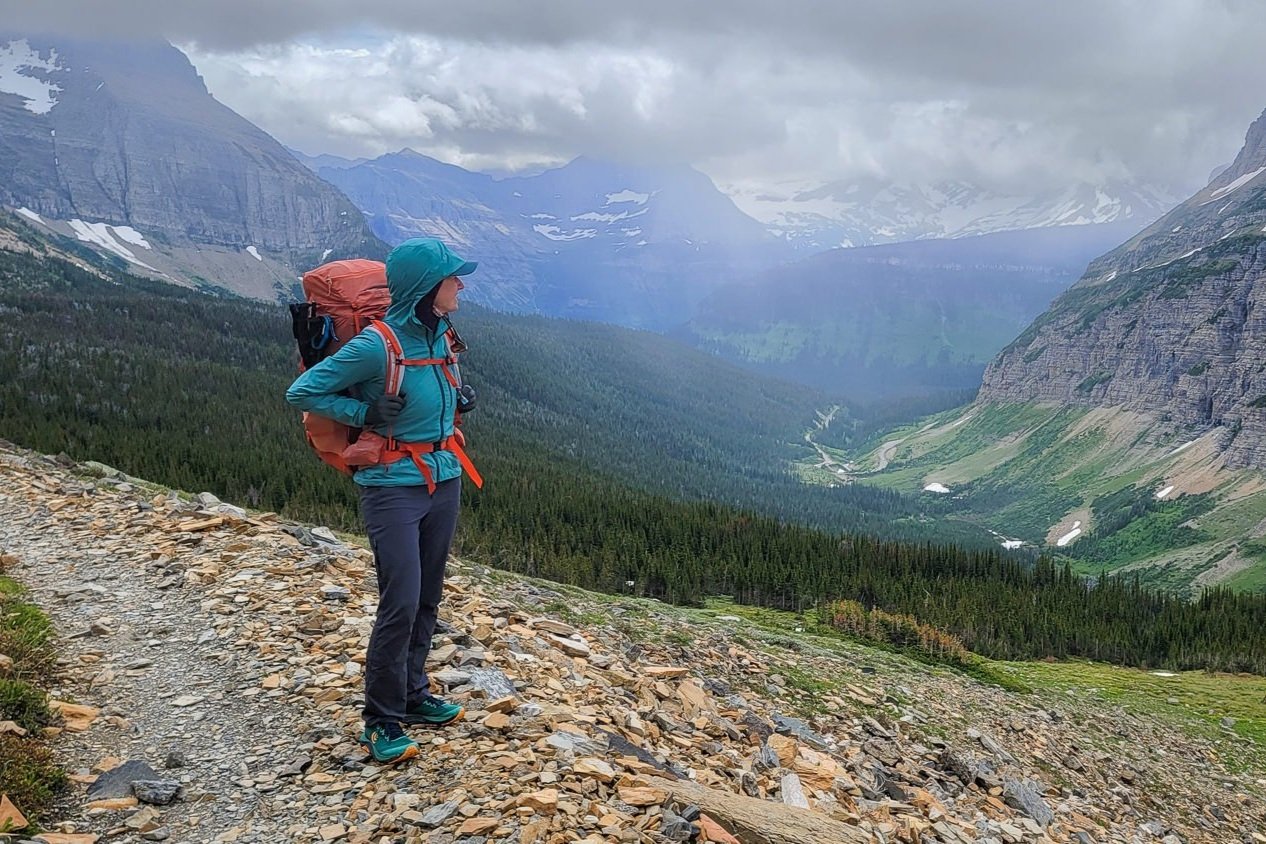
How to Choose Hiking Pants
FABRIC
Many pants use a blend of fabrics to balance durability, weight, cost, and water resistance. Understanding the type of fabrics used can help you choose a pair of pants that fits a specific need.
Nylon
Nylon has several advantages as a garment fabric. It is slightly stretchier than polyester and does not absorb oils, meaning it will not smell after being washed. This fabric is known for being very durable overall and does not absorb much water. Any absorbed water stays cooler than other fabrics, which could be a pro in hot climates.
Polyester
Polyester is a truly hydrophobic fabric, meaning it does not absorb any water, though this depends slightly on the weave’s spacing. On the flip side, it readily holds onto oils, resulting in the fabric retaining body odor, even after going through the wash. This fabric does not stay as cold as Nylon when wet, making it a better choice for hikes in colder conditions.
Cotton
Cotton is widely used in everyday clothing thanks to how comfortable and sturdy it is for the price. Unfortunately, it is also extremely hydrophilic (attracts and retains water). This can be dangerous when hiking because once a cotton garment gets wet, it stays wet for a long time, exposing you to risks of hypothermia. It also may lead to bad cases of chafing due to repeated rubbing on the moist fabric. Therefore, wearing cotton-based fabrics while hiking is generally not a good idea.
Spandex/elastane
Spandex and elastane are often added to the fabric blends used to make pants as they help increase mobility. Nylon and polyester only provide so much give when lifting the leg or making dynamic movements. Adding a stretchier material makes lifting the leg easier, scrambling up a rock face, or getting up off the ground.
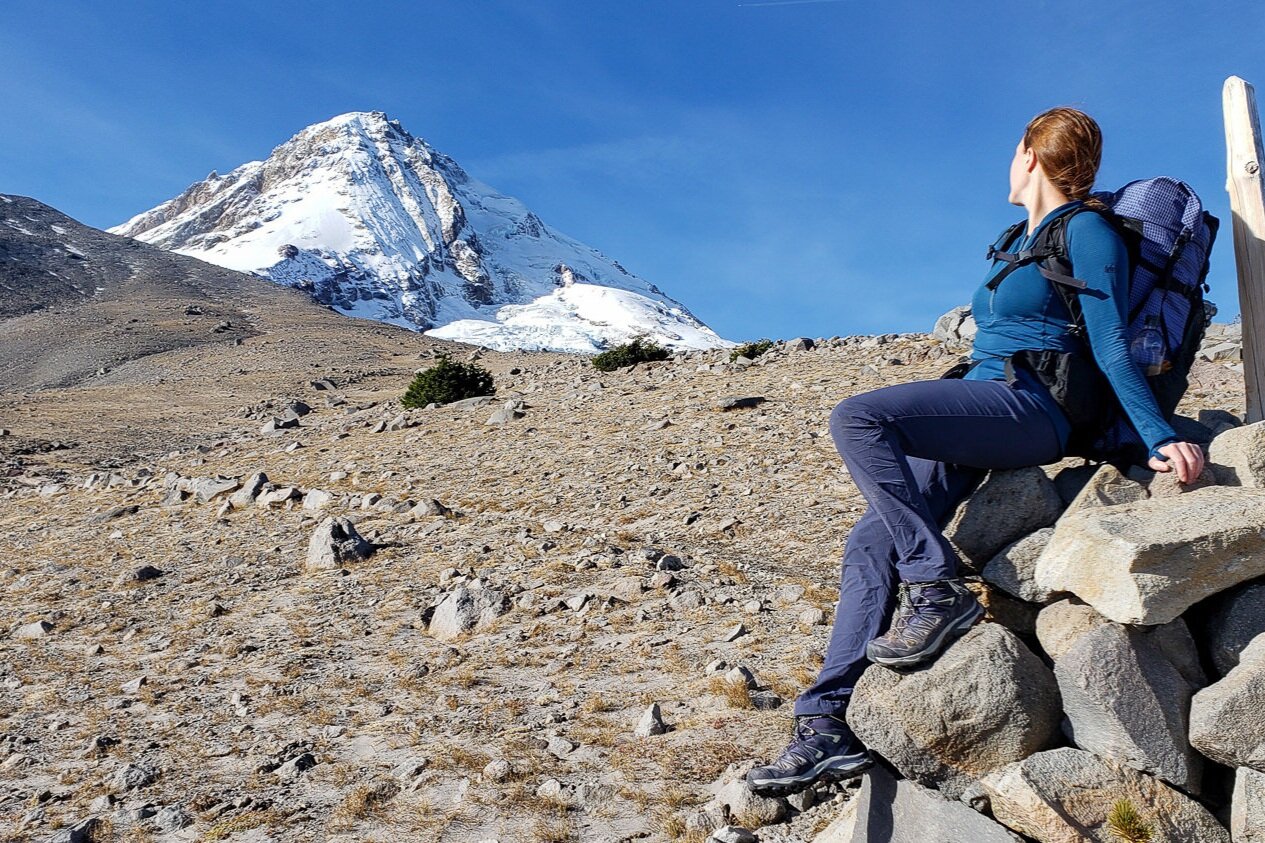
FIT / STYLE
Relaxed fit
Pants cut to have a relaxed fit are meant to be baggier and feel less restricting. The extra space often translates to a more comfortable user experience and better mobility as it is easier to move around.
Slim fit/ straight leg
Slim or straight-leg cuts tend to weigh less, thanks to the minimal material used to make the pants. The downside is that this provides less room for the leg to move, so being cognizant of other features that help with mobility is essential.
Articulated knees & gussets
Extra fabric, directional seams, and different materials at the knees are all strategies to improve mobility while wearing the pants. Pants without these features can feel restrictive in when you’re moving and grooving.
Integrated belts
Adding a drawstring at the waist can be critical for keeping a pair of pants from falling, particularly in models that do not include belt loops. We found that drawstrings made of stretchy material were more difficult to tighten appropriately and that thin material was less comfortable to wear.
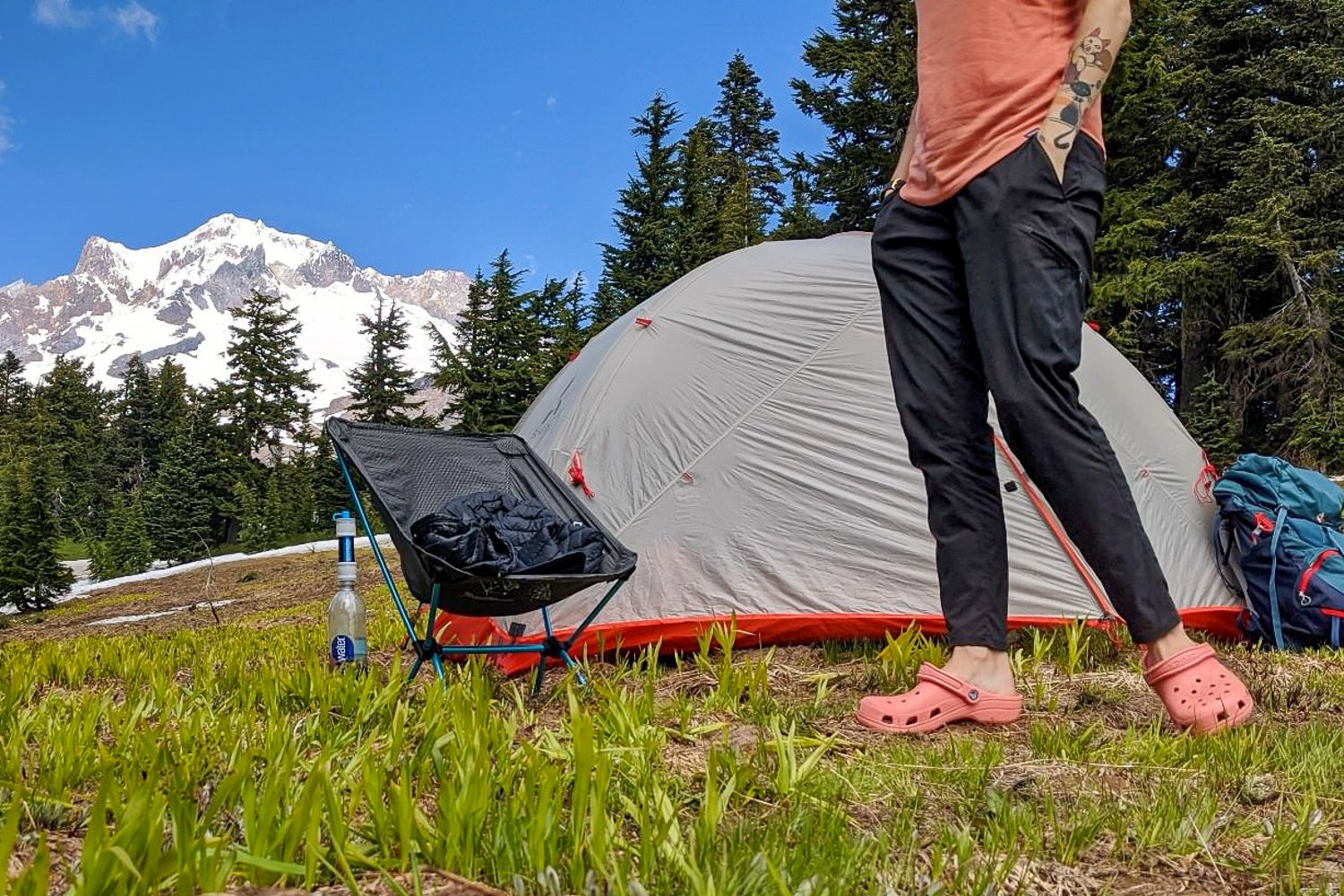
CONVERTIBLES VS ROLLUPS
We tend not to use most of the pockets on hiking pants because items stored in them can feel bothersome and can impede movement. We generally prefer pants with fewer pockets because they look more sleek and feel more comfortable.
Convertibles
Pants that convert to shorts offer the pros of both worlds, but not always the highest quality of both. This pants style is not the most stylish to wear, and sometimes the connection point can feel uncomfortable on the leg. That said, these types of pants offer fantastic ventilation on very hot days and are easier to keep dry during deep water crossings. I can’t tell you how many people I’ve seen fall over while converting these pants, so just be sure to find a safe place to sit when you’re changing them over.
Rollups
In general, rollup-style pants are quicker to adjust and more comfortable than convertibles. Plus, they sport a trendy look. One thing to pay attention to is how high up the cuff’s built-in fabric straps are located: sometimes, the fabric may not be high enough for most creek crossings.
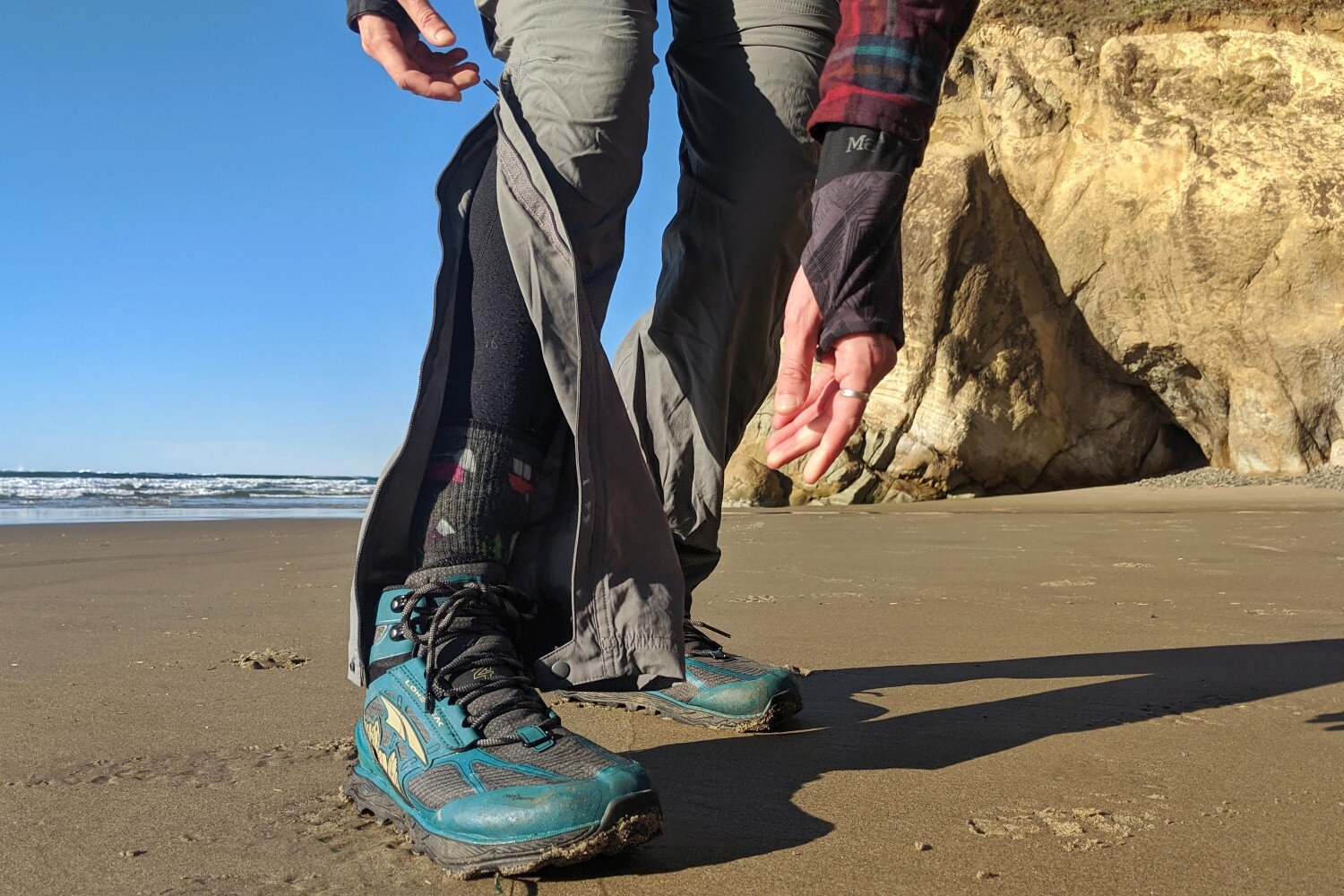
POCKETS
We like the options that pockets provide. Specifically, they make it easier to carry electronics like cell phones or power banks, snacks, sunscreen, maps, headlamps, or other small items with or without a backpack. Because we focus on functional hiking and backpacking attire, we select pants with pockets that keep your things secure.
Back
In our experience, back pockets tend to be the least convenient to use in the backcountry. Unlike hip and leg pockets, it is difficult to reach these pockets while wearing a backpack, making their usability limited.
Hip
Hip-level pockets are generally the most helpful on the trail but can also be the biggest hindrance if they are not designed function-first. Hip pockets are easy to access while wearing a backpack. However, they are also located in an area with a lot of dynamic movement. That means if the pocket does not have the correct shape, some objects may get in the way of leg movement. Another issue is that items may easily fall out if the pocket is too small.
Leg
The comfort and usability of leg pockets primarily depends on the pocket size and how the pants fit. When pants have a very relaxed fit, heavier objects such as cell phones swing around more due to being further from the leg. This can feel uncomfortable over the course of many miles on the trail.
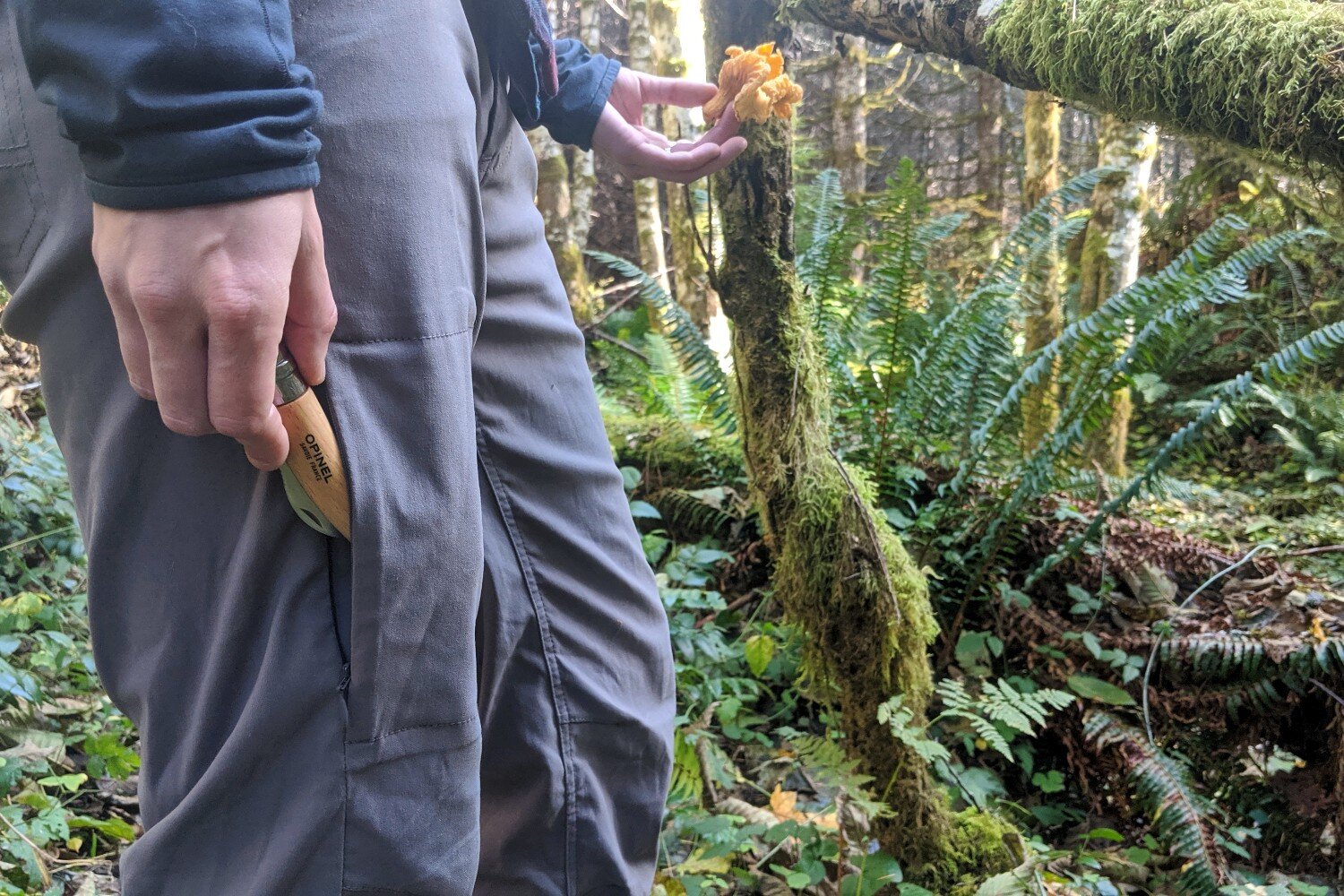
GENERAL CARE
We always recommend reading the care instructions on the label, but here are some strategies for extending the life of a pair of pants.
Use a front-loading washer
Front-loading washers have less hardware and machinery for clothing to catch on. This means that there is less chance of zippers or drawstrings getting damaged in the wash. To reduce the likelihood of damage, we recommend closing zippers and tying waistbands before washing.
Use a technical fabric wash
Outdoor clothing soaps like the Nikwax Tech Wash help extend the lifespan of technical pieces of gear.
Only wash when you really need to
Overwashing wears out even everyday clothing items. Fortunately, most technical clothing has antimicrobial properties that keep them from smelling and should not need to be washed as frequently.
Don’t use fabric softener or dryer sheets
Fabric softeners and dryer sheets can leave remnants on the fabric, which impacts how the pants perform.
Hang dry when possible
The extra heat and pounding from the drying process can increase how quickly a pair of pants wears out.
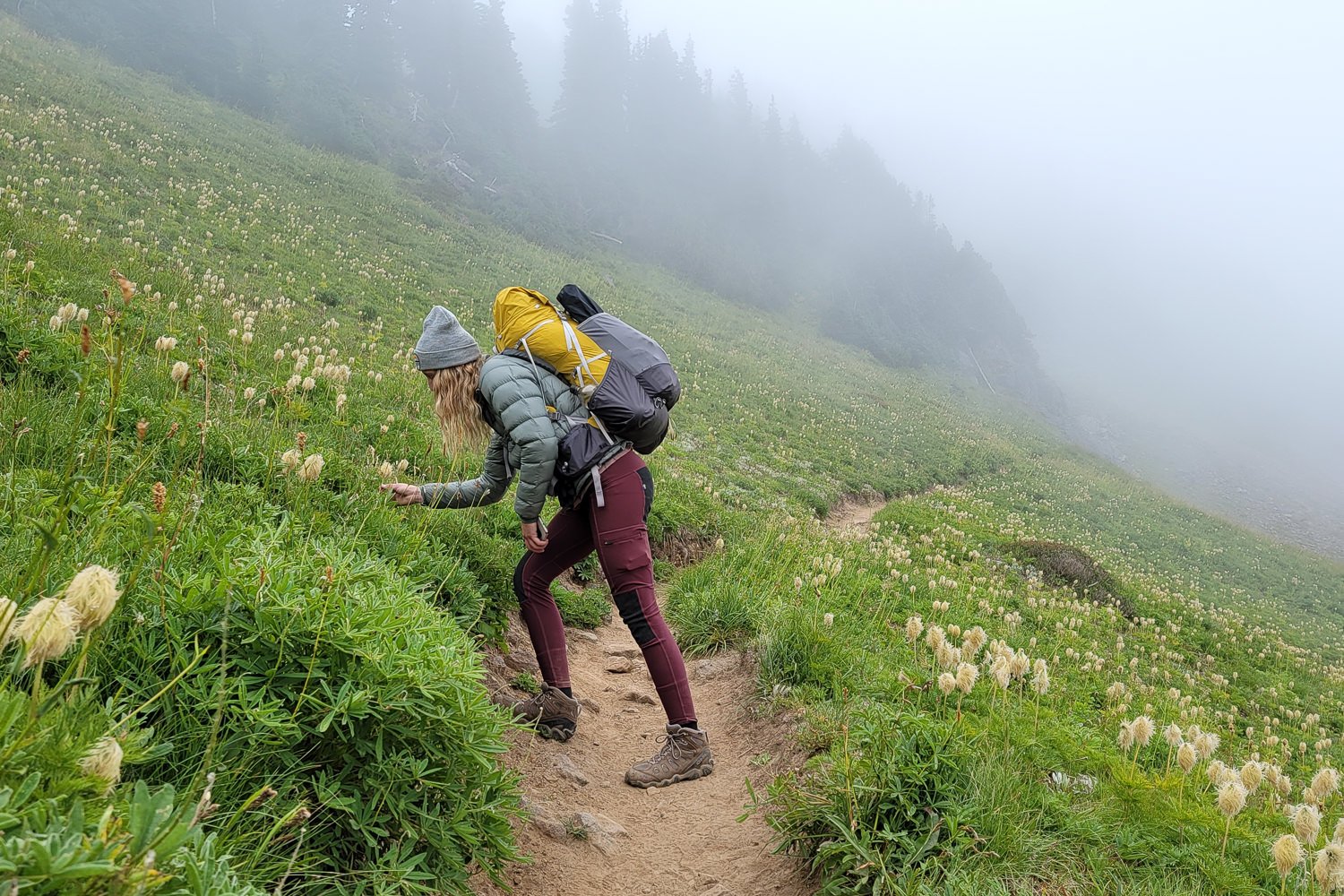
Conclusion
Finding the ideal pair can be overwhelming with so many hiking pants types and styles. Fortunately, we have spent weeks field-testing and strutting our stuff in the best of the best to assess how well these pants perform. We hope this article will provide the clear and concise information needed to make an informed buying choice.


